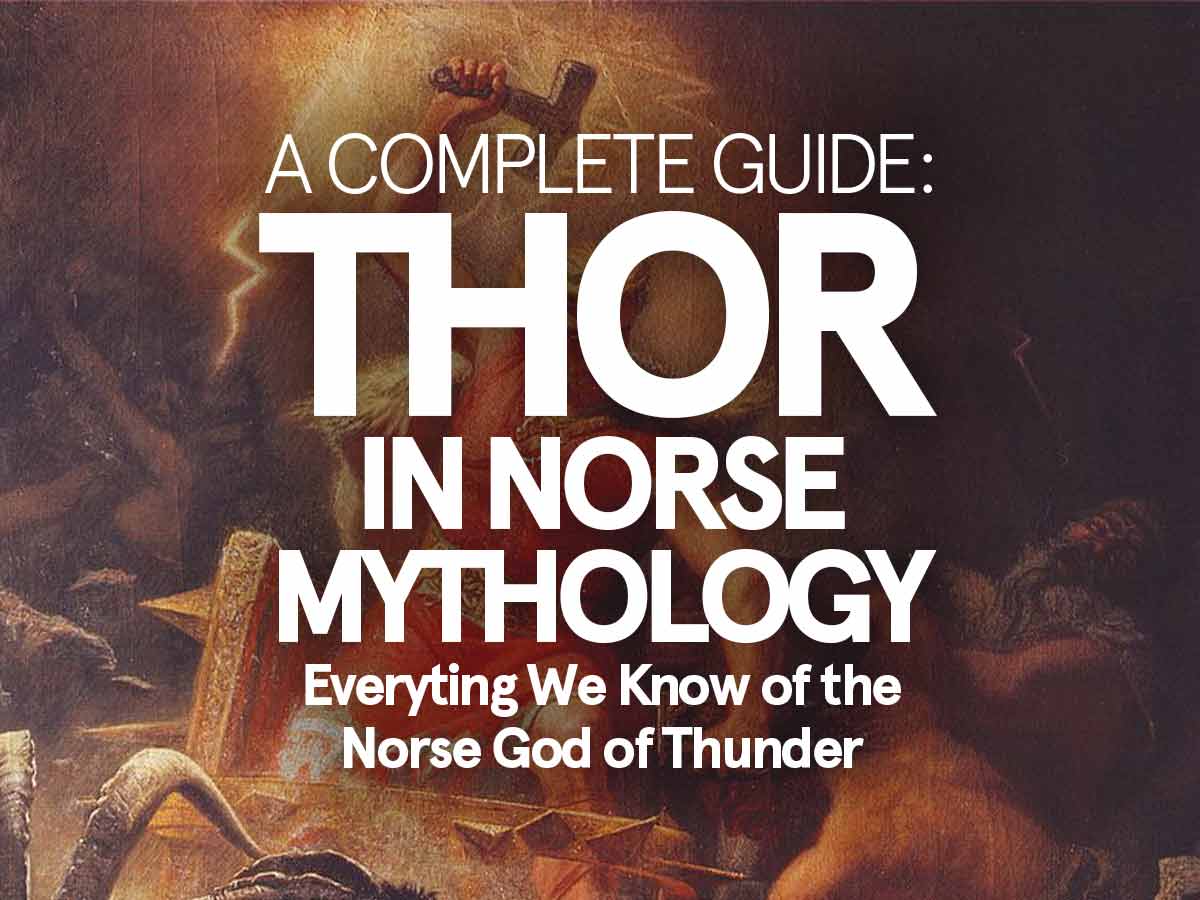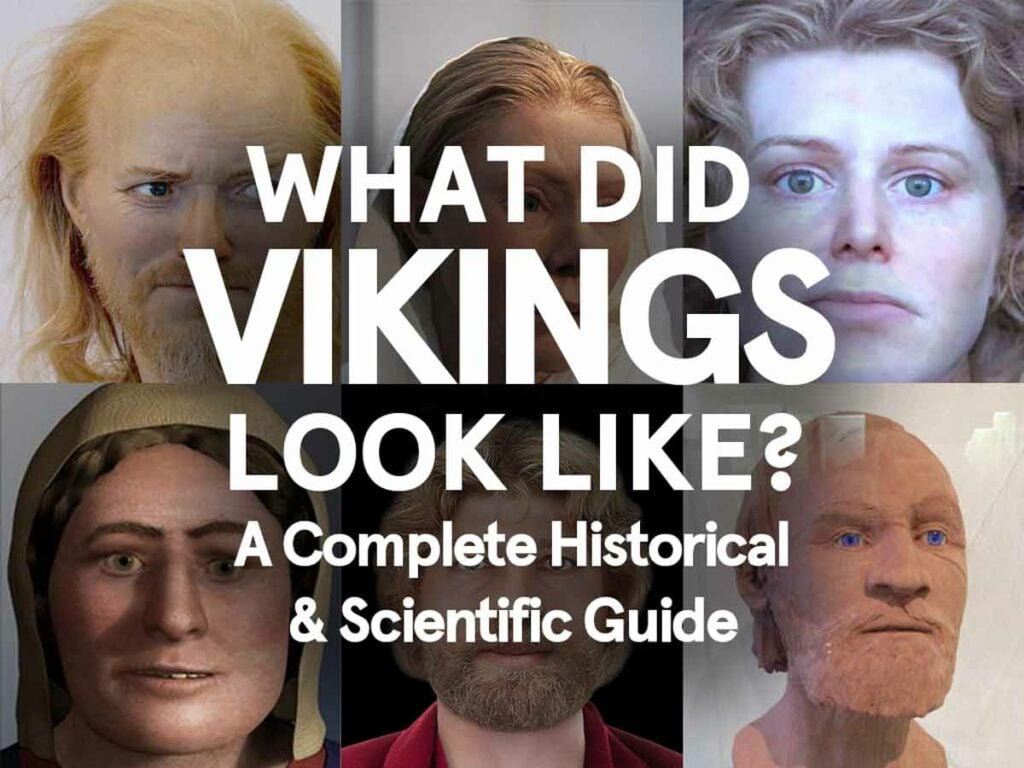I like to see the Æsir kick some ass on the big screen as much as the next guy, but it’s high time we separate the Marvel Thor from the one in the Norse sagas. Believe it or not, the Thor from Norse mythology was likely not seen as the handsome, chiseled, blond, flying, and time-traveling hunk you’ve seen in the MCU movies. In Norse mythology, the thunder god is primarily described as a stout, red-haired, temperamental, and fiercely strong warrior, who loves to knock down vast quantities of mead and even dress up as a lady (!) in order to get his lost hammer back.
That said, the MCU Thor isn’t completely off the mark, as he is extremely strong and has his trusty hammer, Mjölnir, which “would never miss its target and would never fly so far that it did not seek its way back to the thrower’s hand”.
But in the sagas, we also learn about his magical belt Megingjord, which gives him double the strength, and his protective iron gloves Járngreipr, which he needs to wear in order to be able to wield the mighty Mjölnir.
So, while the Marvel movies may have gotten some things right about Thor, they’ve also missed the mark in many ways. But fear not, dear reader, for there is still time to get to know the “real” Thor. Let’s begin, shall we?
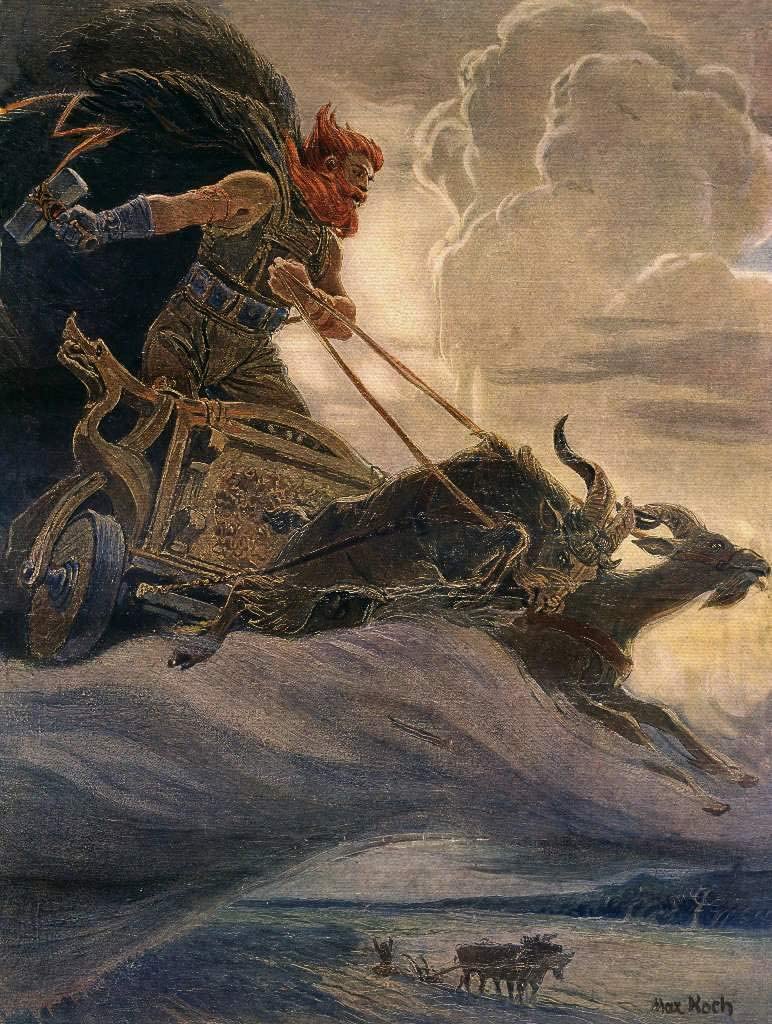
- Thor – The Norse God of Thunder, Lightning, Storms, Sacred Groves & Trees, Strength, Fertility, and Protector of Humankind
- Thor's Appearance – Do We Know What Thor Actually Looked Like?
- Thor's Personality – Courageous, Mead-lover, Hot-headed & Righteous
- Thor's Family – Parents, Wife, Lover, Children
- Thor's Powers, Gears & Animals – Mjölnir & Co
- Symbols Commonly Associated with Thor
- Thor's Adventures in the Norse Sagas
- When Loki Cuts Sif's Hair Off and Thor Gets His Hammer as an Apology
- Loki's Affair with Sif and General Instigations, Followed by the Wrath of Thor
- The Theft of Mjölnir and Thor's & Loki's Adventure with the Giants
- Thor's and Hymer's Fishing Trip & When They Managed to Hook the Midgård Serpent
- Thor's and Loki's Journey to Utgård, and Their Humiliation
- Ragnarök, the Battle with Jörmungandr, and the Death of Thor
- Archeological Records Associated with Thor
- Modern Viking Art Depicting Thor
- Thursday - Thor's Day
- Thor and Similar Gods from Around the World
- Modern Interpretations & Popularity
Thor – The Norse God of Thunder, Lightning, Storms, Sacred Groves & Trees, Strength, Fertility, and Protector of Humankind
Reading out all of his areas of influence sure is a mouthful, but it’s also no surprise since Thor is the second most prominent figure in Norse mythology after Odin.
Although he is mostly known as the god of thunder he was perhaps more importantly commonly known as the protector of the common people—which may explain his popularity among the Norse Scandinavians.
To illustrate this, the English abbot Aelfric wrote in the 10th century that Thor was the deity “the Danes loved most”.
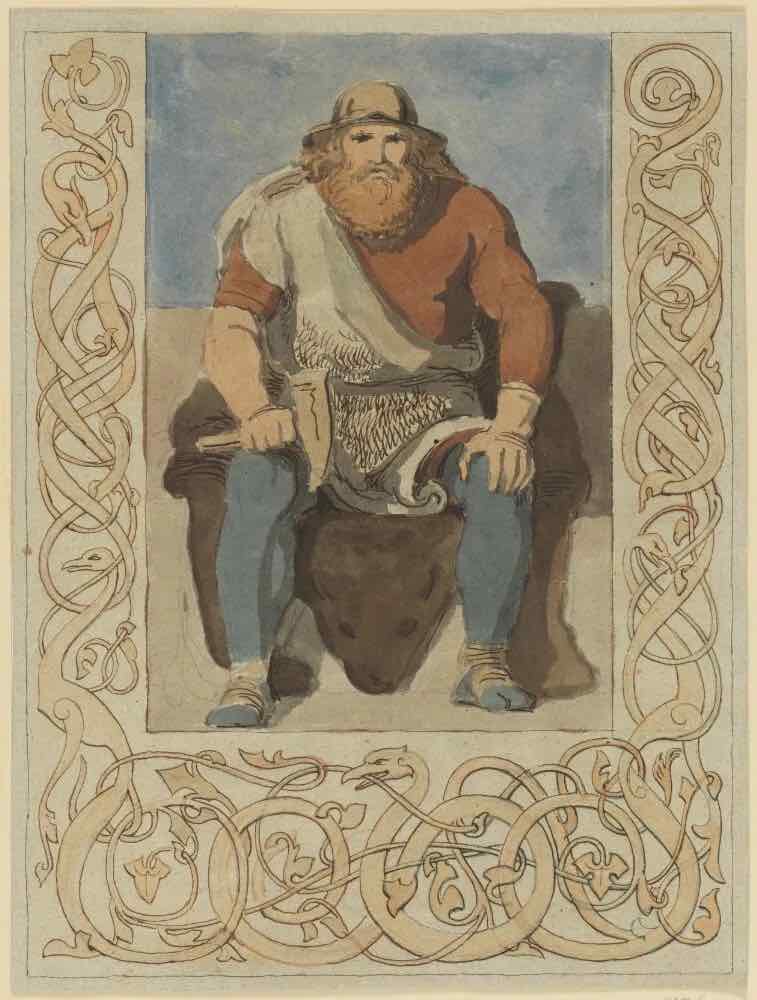
Because based on the sagas and archeological evidence left behind, Thor was without a doubt the most popular god in Viking Age Scandinavia.
And that’s not really hard to imagine considering he is the son of Odin, the king of the gods, and Jörð/Fjörgyn, the earth goddess, and heavily associated with protecting the common folk, strength, courage, and fertility.
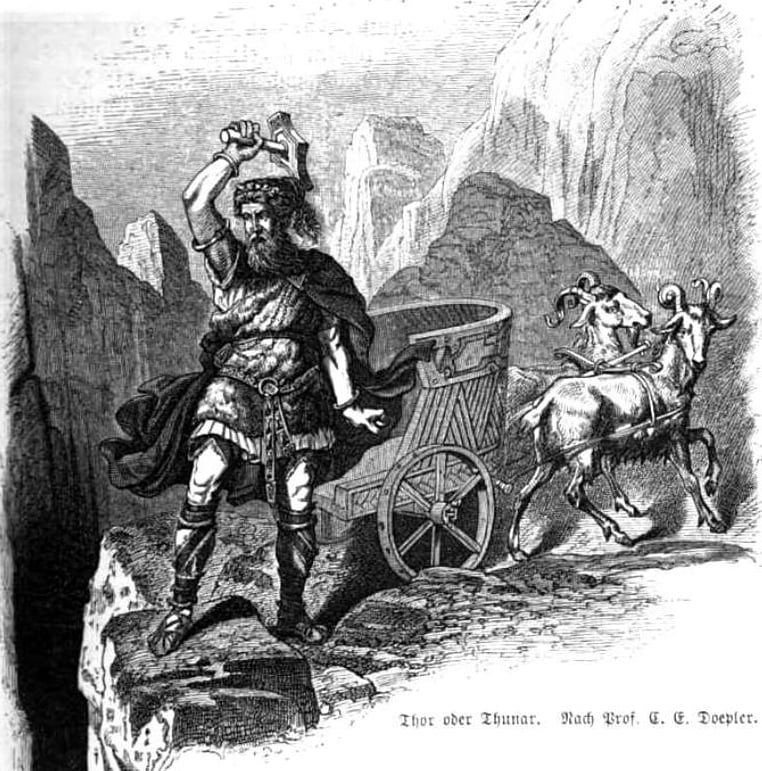
Here is how Thor is described in Skáldskaparmál:
He may be called the son of Odin and Mother Earth, the father of Magni, Móði, and Þrúðr, the husband of Sif, the stepfather of Ullr, the ruler and owner of Mjölnir, the belt of strength, and Bilskirnir, the defender of Asgård and Midgård, the enemy and bane of the giants and sorceresses, the bane of Rugner, Geirröd, and Thrivalde, the lord of Tjalfe and Röskas, the enemy of the Midgård Serpent, the fosterson of Vingner and Loras. The skald Brage calls him Odin’s heir.
— Snorri Sturluson, Skáldskaparmál, ch. 4
One of the most common depictions of Thor on runestones, jewelry, pendants, and other items is with his legendary hammer, Mjölnir, which is said to be able to level mountains and create thunder and lightning—and truly instrumental in his epic battles against the giants.
To sum it up, Thor represents the ideal Old Norse warrior: strong, brave, and fiercely loyal to his family and friends.
Let’s explore exactly what the Norse sagas and archeological evidence can tell us about this mead-loving, adventurous, and vengeful thunder-god.
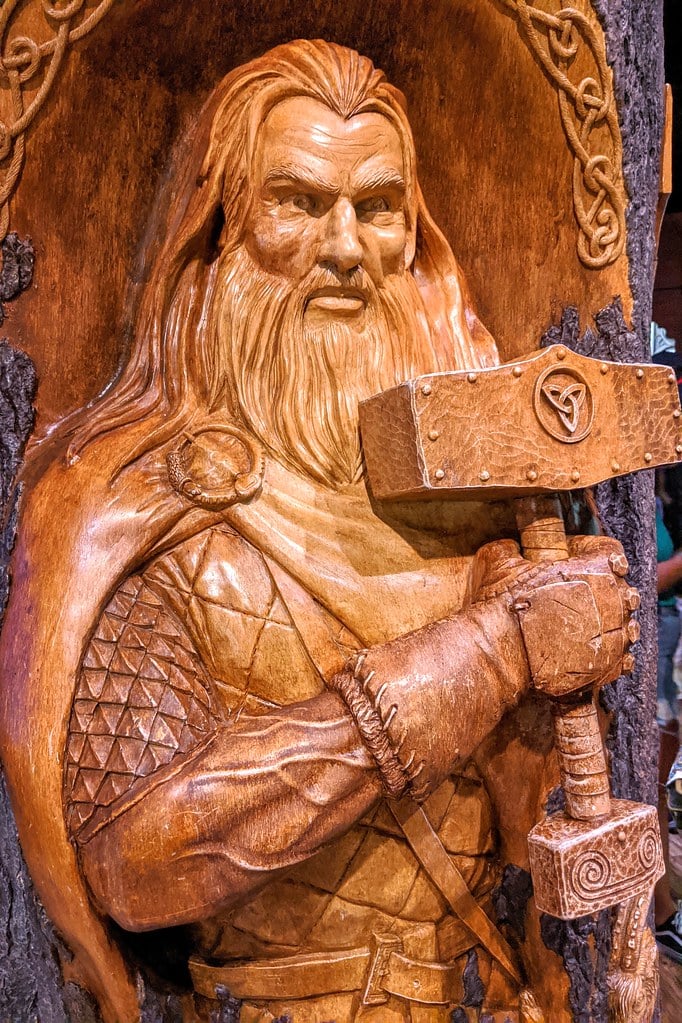
Where Does Thor Live?
Thor rules in a Kingdom called Þrúðvangar (or Trudvang, which means “fields of power” in Old Norse), and lives in a hall called Bilskirnir (“lightning-crack”), which is so big it contains 540 rooms, according to Gylfaginning ch. 21. Þrúðvangar is located within Asgård, the realm of the Æsir.
Thor is foremost among them; he is called Asa-Tor or Åke-Tor. He is the strongest among gods and men. He owns the kingdom called Trudvang, and his hall is called Bilskirne. In this hall are five hundred rooms and forty more. It is the largest house ever built.
— Snorri Sturluson, Gylfaginning, ch. 21
Thor’s Appearance – Do We Know What Thor Actually Looked Like?
We’re not spoiled with descriptions of Thor’s actual appearance, but if we analyze all the parts that somehow describe how he looks, this seems to be the consensus:

He likely has red hair and definitely a red beard
Despite most of us assuming Thor has an attractive blonde mane and is fairly clean-shaven (based on Stan Lee’s interpretation of the thunder god), he seems more likely to have had red hair, and very likely to have a big red beard if we look at the available material.
One of the sources that touch on this is Flóamanna saga, where a dream reveals a man we later are told is Thor:
He begins and dreams that a man comes to him with a big red beard and says: “You have planned a journey for yourself and it will be difficult.”
Flóamanna saga, Ch. 21
Here is the part where we find out it’s Thor he’s speaking to:
Then it seemed to him that Thor moved to some hammers where a sea storm broke in the rocks, and now Thor says: “In such a storm you must stay and stay in the wilderness for a long time and be tormented in misery and danger unless you become my man.”
Flóamanna saga, Ch. 21
Yet another mention of Thor’s notable red beard can be found in Eíríks Saga Rauda:
Then began Thorhall, and said, “Has it not been that the Redbeard has proved a better friend than your Christ? this was my gift for the poetry which I composed about Thor, my patron; seldom has he failed me.”
Eíríks Saga Rauda, Ch. 8
Finally, we also get a description of his red hair in Jacob Grimm’s Teutonic Mythology:
So then, as the god who lightens has red hair ascribed to him, and he who thunders a waggon, he who smites has some weapon that he shoots.
Teutonic Mythology, Thunar, Jacob Grimm
We do, however, see a description from Snorri Sturluson of Thor having golden hair, with the prologue to his Heimskringla reading “His hair is fairer than gold”—so it’s impossible to be 100% sure of the color of his hair, though red seems the most likely to me.
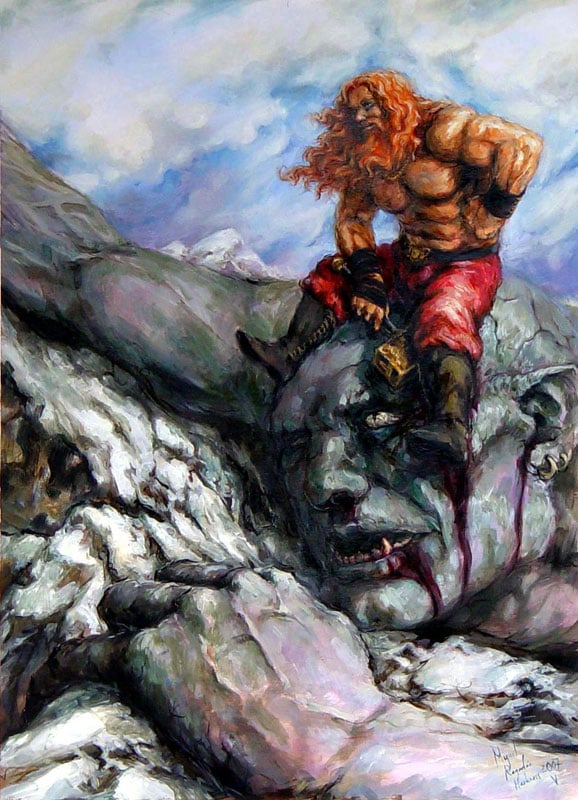
He was a stout man and by far the strongest Æsir
Time and time again we are told of Thor’s extreme physical strength, not the least in battles with his legendary hammer, but also in a more standard situation where the hammer isn’t mentioned.
One such example is in Hymiskviða when he with ease impressed the giant Hymer by carrying two whales and a boat, as well as a giant brewing kettle no one else could carry.
This strength, in combination with his voracious hunger and thirst for mead (the giant brewing kettle was required due to his own request for bottomless mead essentially), makes it fairly obvious that Thor was a very stout figure; extremely strong, bot also with what we today would call a “dad bod” (i.e. fairly chunky but no flabby fat).
Thor’s Personality – Courageous, Mead-lover, Hot-headed & Righteous
Thor was quite the hot-headed personality, and definitely embodied the ideal of a heroic warrior in Viking age Scandinavia. He was brave, powerful, righteous, and always ready for adventure—but at the same time good-natured, and the guardian of all humans in Midgård (the human realm, earth).
He was definitely not perceived as gentle or loving, and he absolutely loved chugging mead in epic feasts with his fellow Æsir, but he was also known to protect the common folks with his supreme strength and conviction.
Despite being hot-headed at times, Thor was never cruel or malicious by Viking standards. He was evidently an inspirational example of loyalty and honor to many at the time — embodying the archetype of the perfect hero.
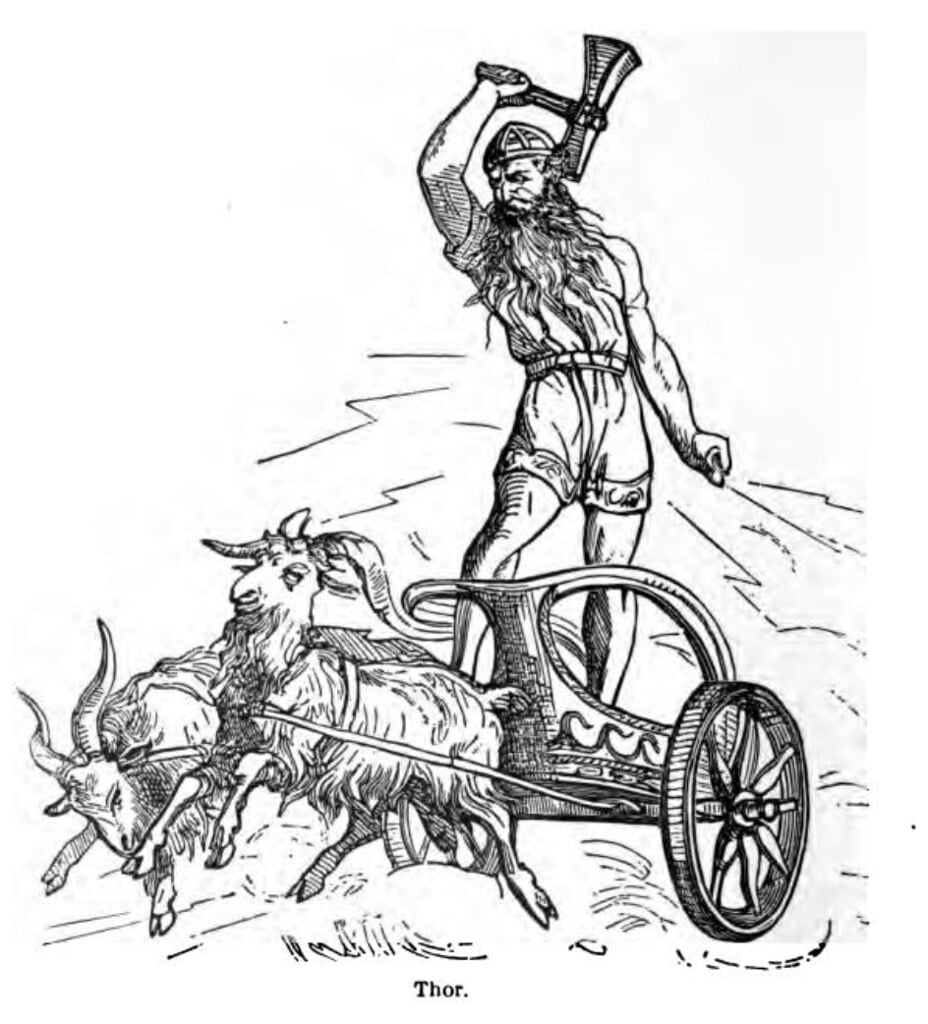
Thor’s Family – Parents, Wife, Lover, Children
As we’ve mentioned already and as you’ve likely heard before anyway, Thor is the first-born son of Odin, the All-Father, and the Jötunn Jörð (also known as the earth giantess, synonymous with earth itself).
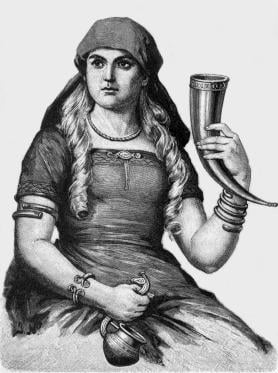
He is married to Sif, whom he has two children with, Trud and Móði. He also has another son, Magni, from his previous marriage with giantess Járnsaxa, as well as his adopted stepson Ullr (Sif’s son).
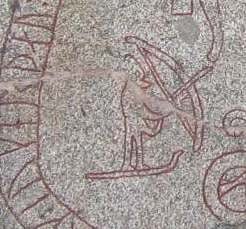
As the son of Odin (a notorious womanizer) he also has a slew of brothers, including Baldr, Hermod, Höder, Víðarr, and Vale.
Thor’s grandfather is Borr, and his great-grandfather was Burí — the father of all Norse gods. His grandmother is Bestla, and his great-great-grandmother is Auðumbla, the primeval cow who gave nourishment to the first jötunns and licked away the ice to reveal Burí (likely a reference to when the last ice age ended in scandinavia).
The Children of Thor
Thor might be married to Sif, but he also had a lover in Járnsaxa, and they each mother two of his sons who encapsulate all the might of Thor: Magni and Móði. The names of these sons reflect their father’s power – Magni means “Mighty” and Móði translates as “Courageous”.
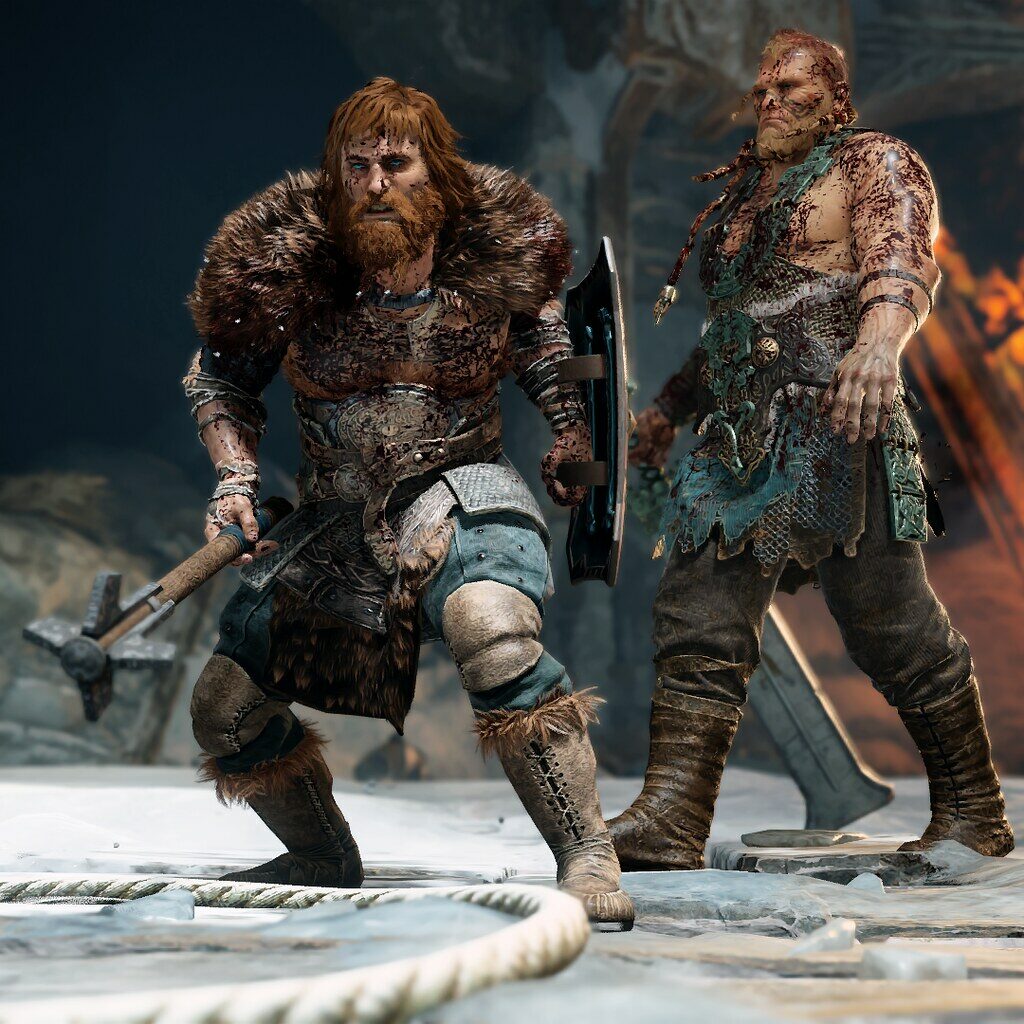
With his wife, the beautiful Sif, Thor also had two other children; Þrúðr (Thrud, or Trudy as we’d say today), who is possibly also a Valkyrie, and his stepson Ullr who is famous for his archery and possibly also a very powerful wizard and stand-in for Odin according to the Gesta Danorum.
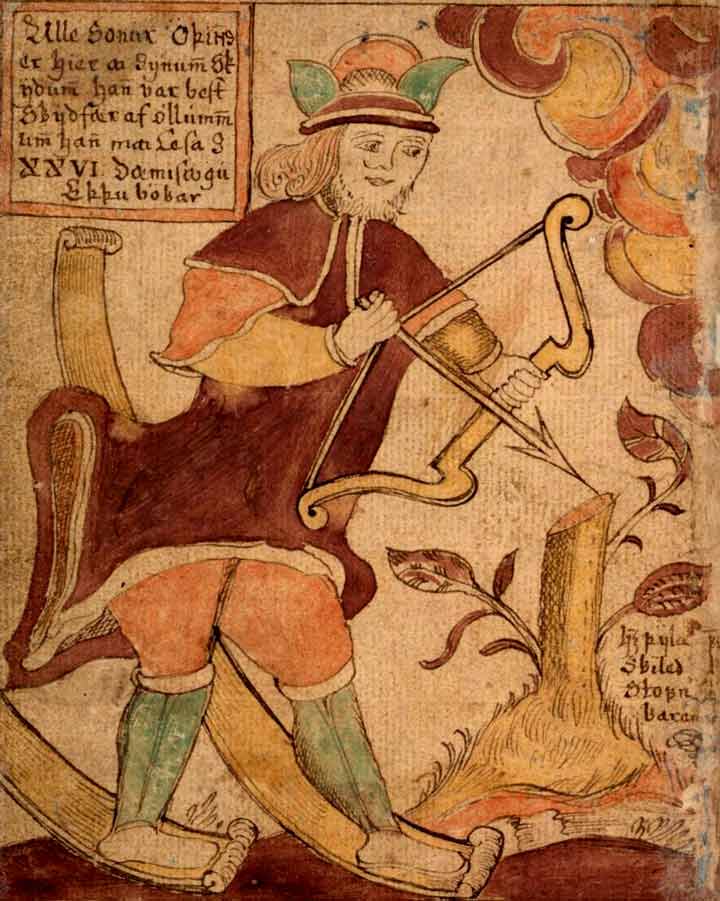
He was such a cunning wizard that he used a certain bone (probably a sledge or similar conveyance), which he had marked with awful spells, wherewith to cross the seas, instead of a vessel; and that by this bone he passed over the waters that barred his way as quickly as by rowing
Gesta Danorum, Saxo Grammaticus
Thor’s Powers, Gears & Animals – Mjölnir & Co
Thor is known as the physically strongest of all the Old Norse deities, but he is also the second most powerful (after Odin) in part due to his weapons and other nifty gadgets. These include:
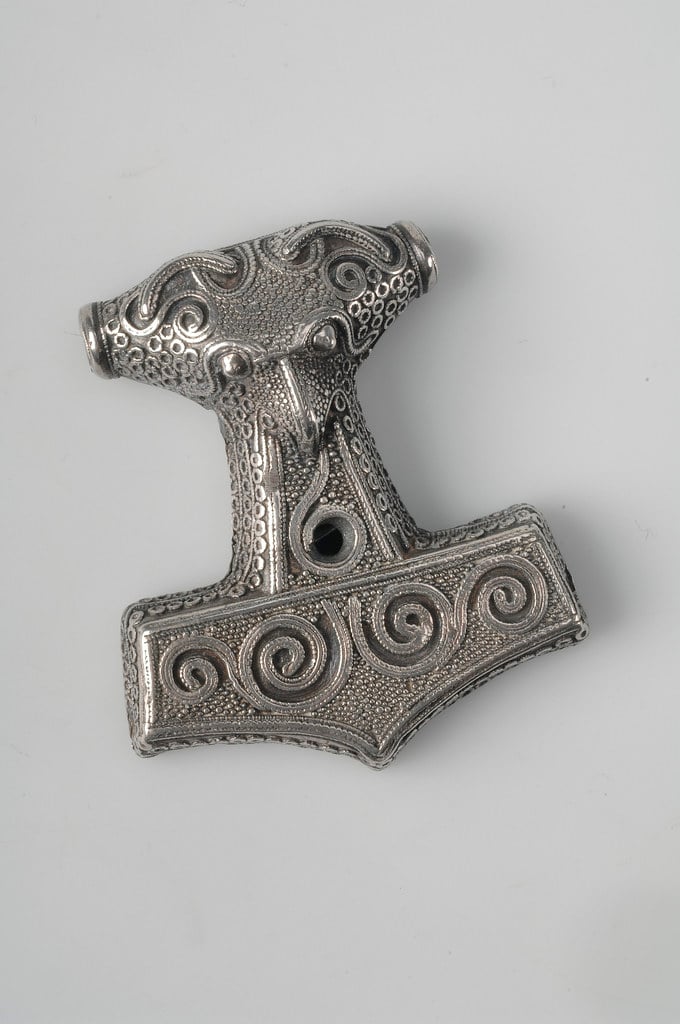
- His main weapon, the mighty hammer Mjölnir.
- His magical belt, Megingjörð, which gives him double the strength when he tightens it.
- His iron gloves Járngreipr, which are necessary in order to wield Mjölnir.
- His iron staff Gríðarvölr
Mjölnir was manufactured by the black elf brothers Brokkr and Sindri, after they were tricked by Loki into making something as powerful as Odin’s Gungir spear.
Then he gave Thor the hammer and said he would be able to strike as heavily as he liked, whatever the target, and the hammer would not fail, and if he threw it at something, it would never miss, and never fly so far that it would not find its way back to his hand.
— Snorri Sturluson, Skáldskaparmál, ch. 35
We’ll dive deeper into this story a bit further into the article.
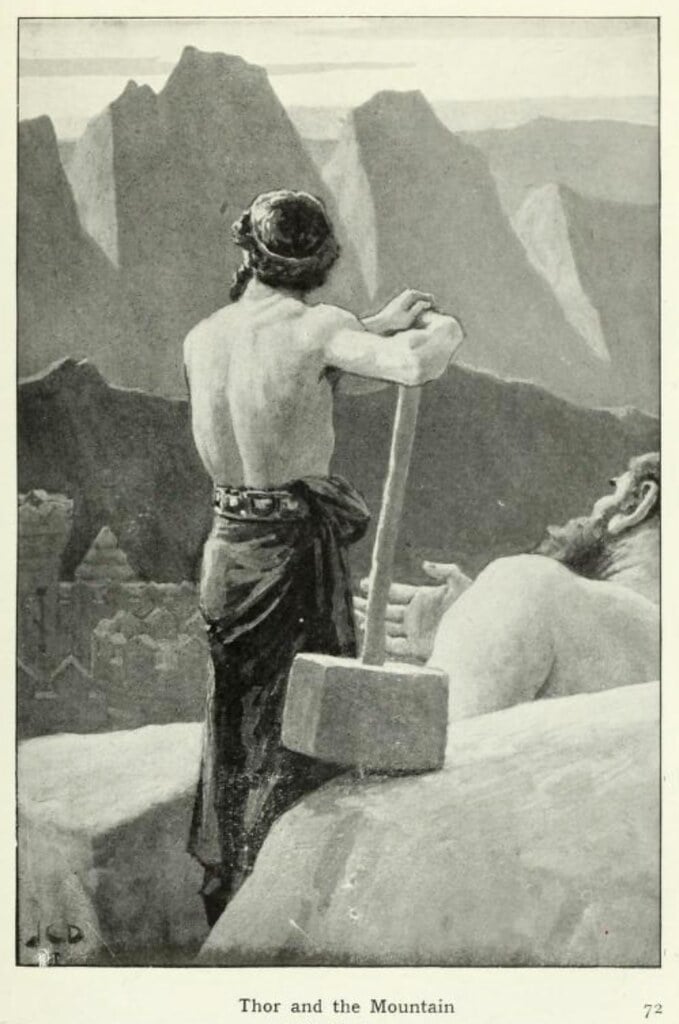
He receives all of these items, except Mjölnir, from the giantess Grid:
Thor lodged for the night with a giantess called Grid. She was Víðarr the silent’s mother. She told Thor the truth about Geirrod, that he was a cunning giant and awkward to deal with. She lent him a girdle of might and some iron gauntlets of hers, and her staff, called Grid’s pole.
— Snorri Sturluson, Skáldskaparmál, ch. 18
His hammer can be used for both destruction and purification which makes it an incredibly powerful weapon, but despite what the Marvel movies would like you to believe, he does not generally fly with the hammer.
Symbols Commonly Associated with Thor
Thor is a very prominent figure in the sagas as well as from archeological finds dated back to Viking Age Scandinavia, and has a number of symbols associated with him:
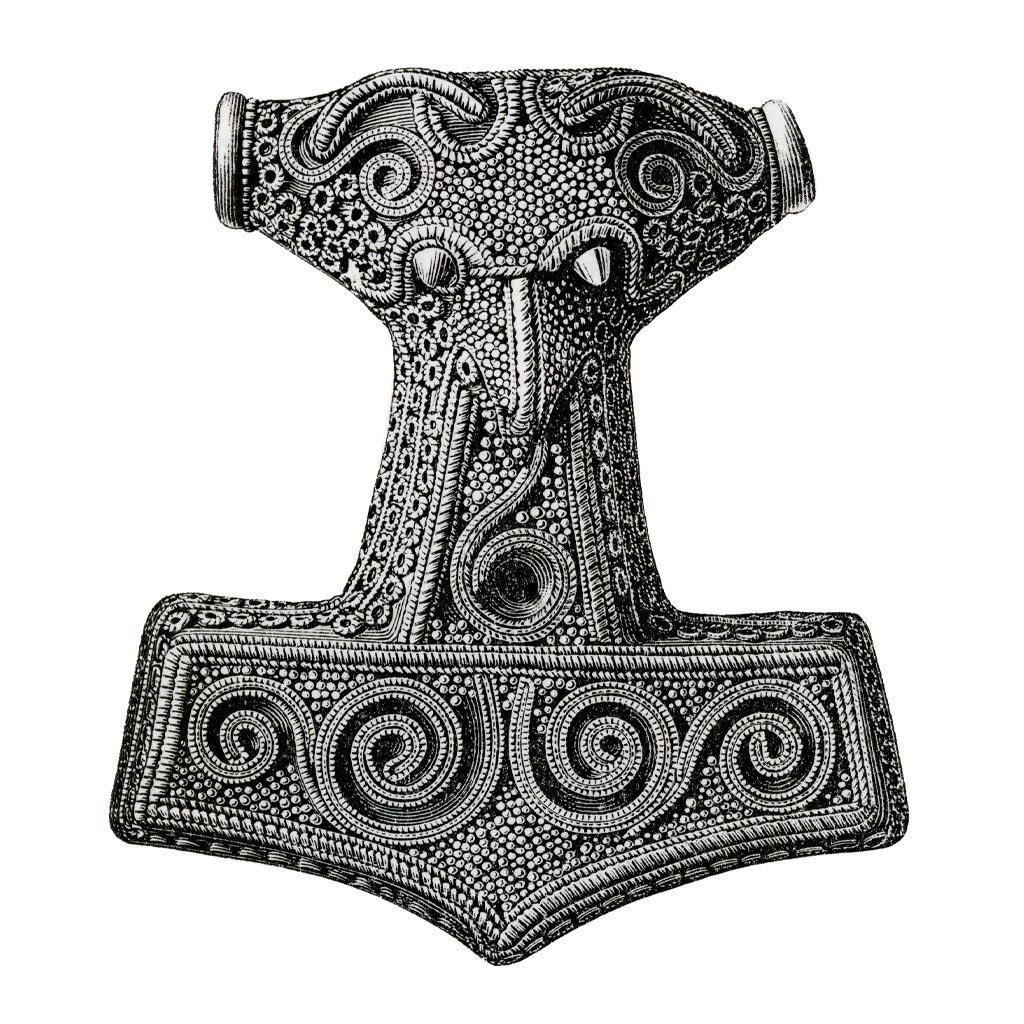
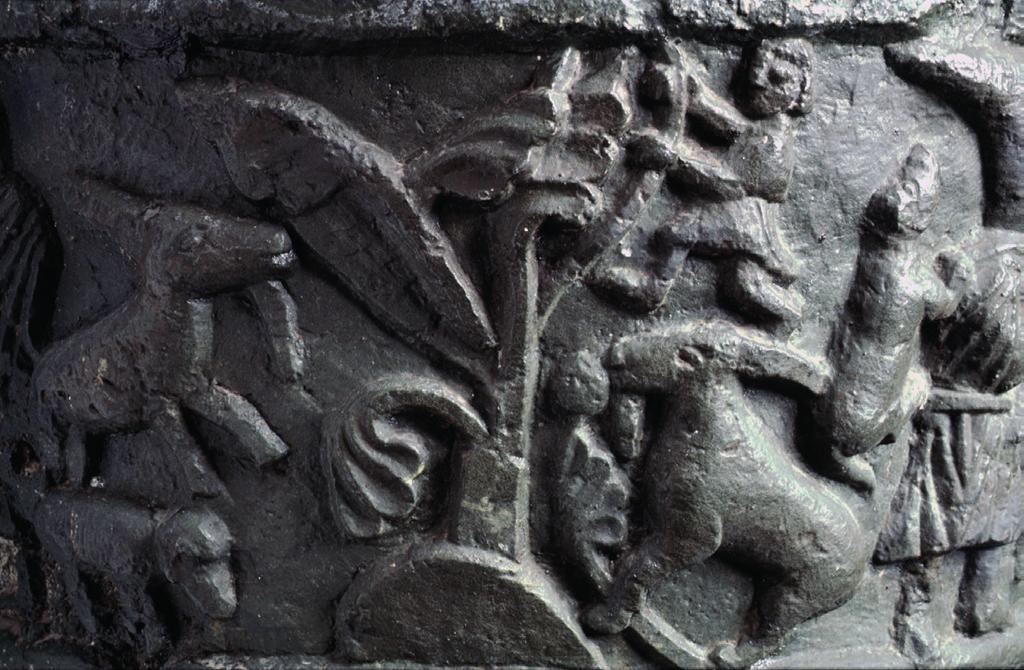
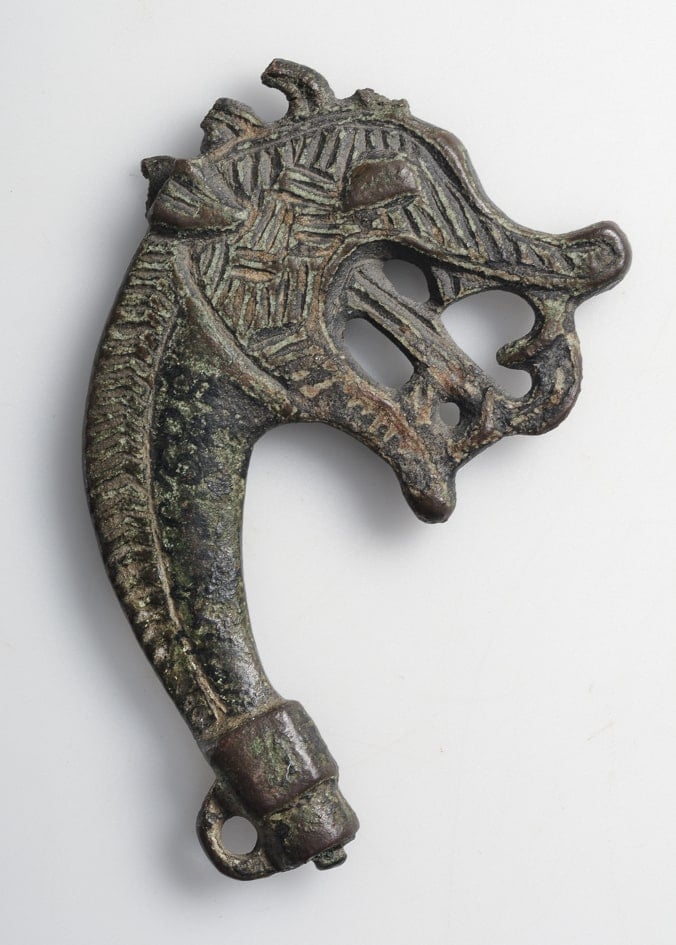

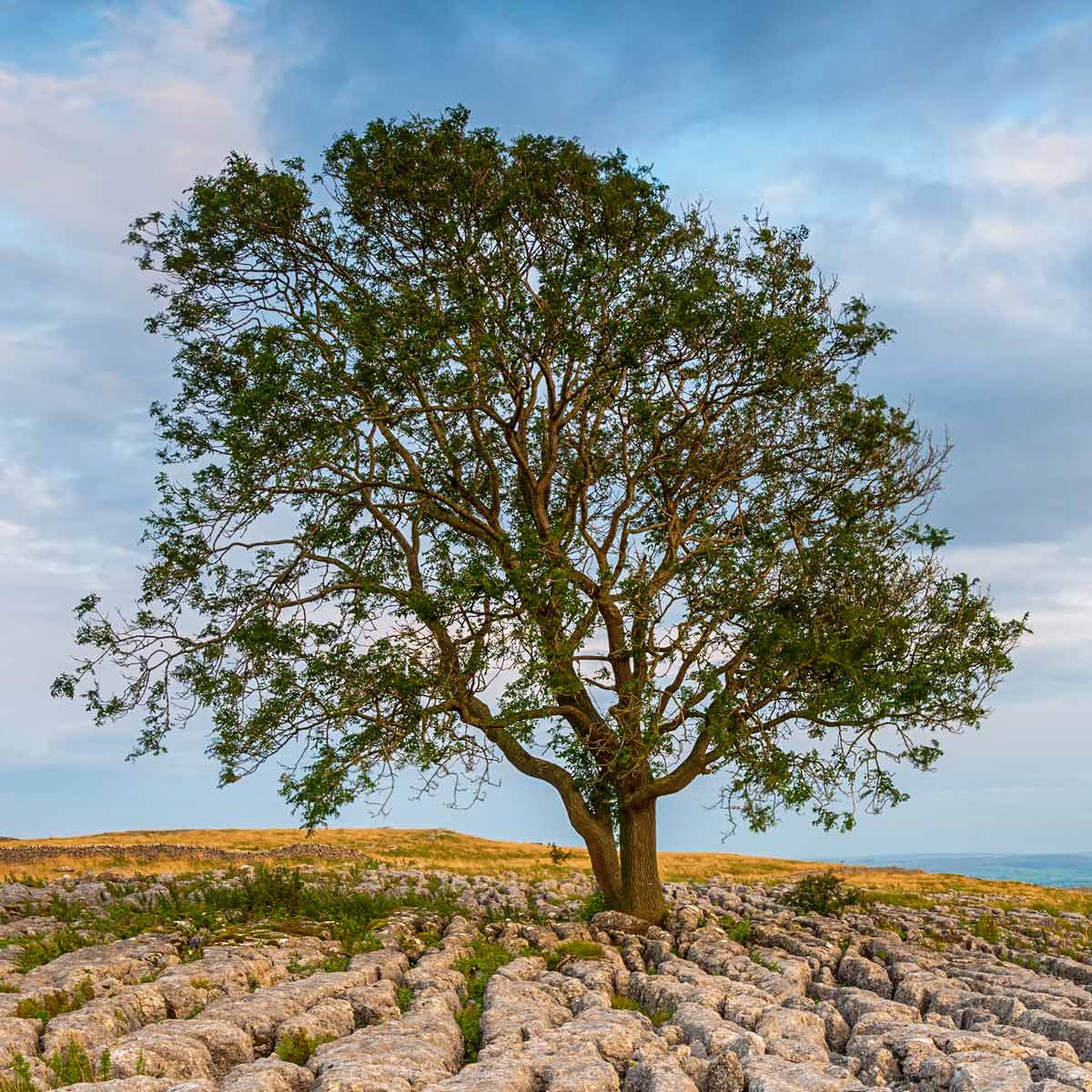
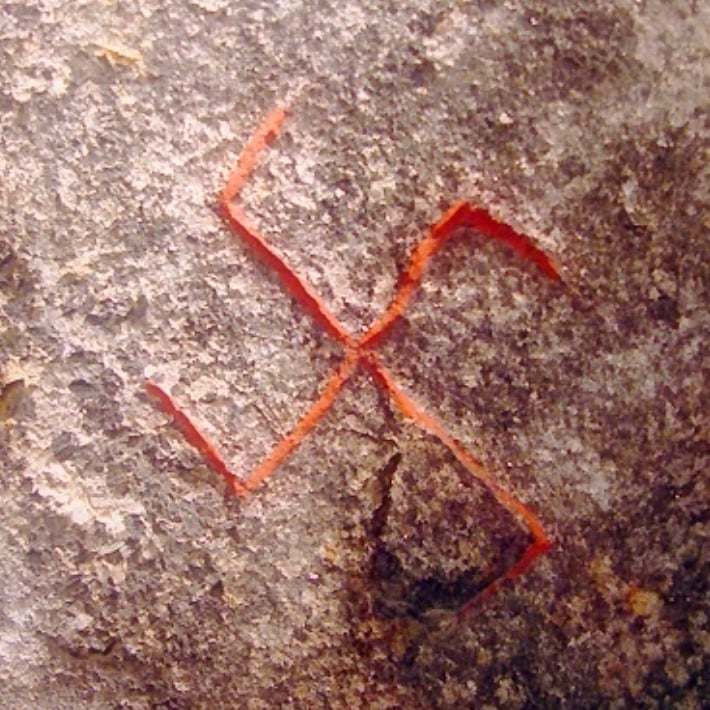
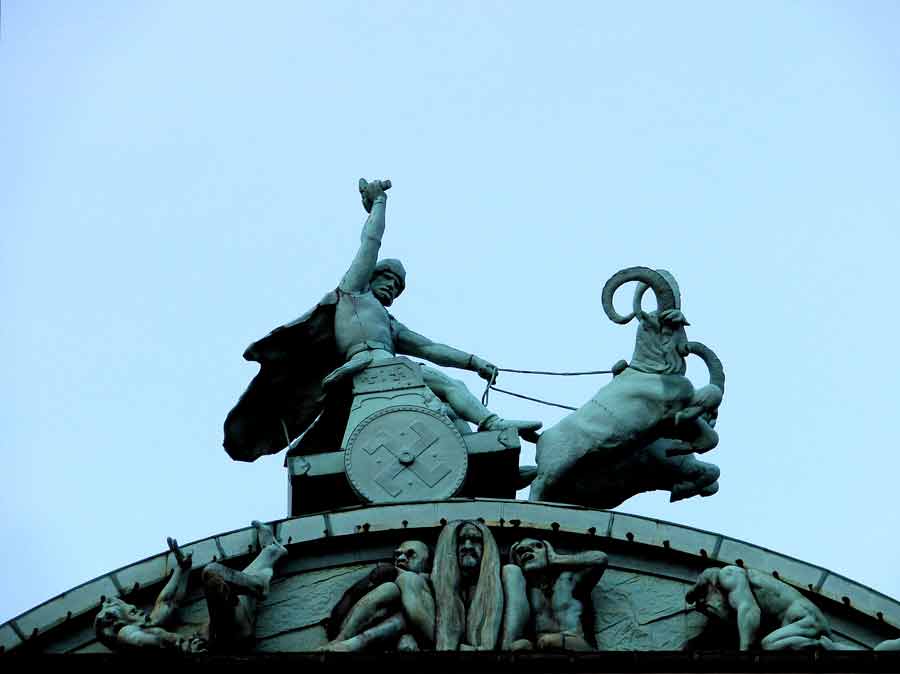
Thor’s Adventures in the Norse Sagas
Now that you’ve learned who Thor is, what his powers are, and which kinds of weapons he wields, let’s dive into some of his epic adventures that were passed down orally in Scandinavia for a thousand years from generation to generation, before finally (and luckily for us) being written down by Snorri Sturluson in his Heimskringla (a.k.a. the Prose Edda).
When Loki Cuts Sif’s Hair Off and Thor Gets His Hammer as an Apology
In Skáldskaparmál, we learn of the time Loki randomly decided to cut some of Sif’s hair off, “for mischief’s sake” and to stir up some drama (I guess he was bored?).
Thor wasn’t too happy with his decision though, and threatened to “break every bone in him” which made Loki swear that he would fix it by making the Black Elves Brokkr and Sindri make Sif golden hair instead.
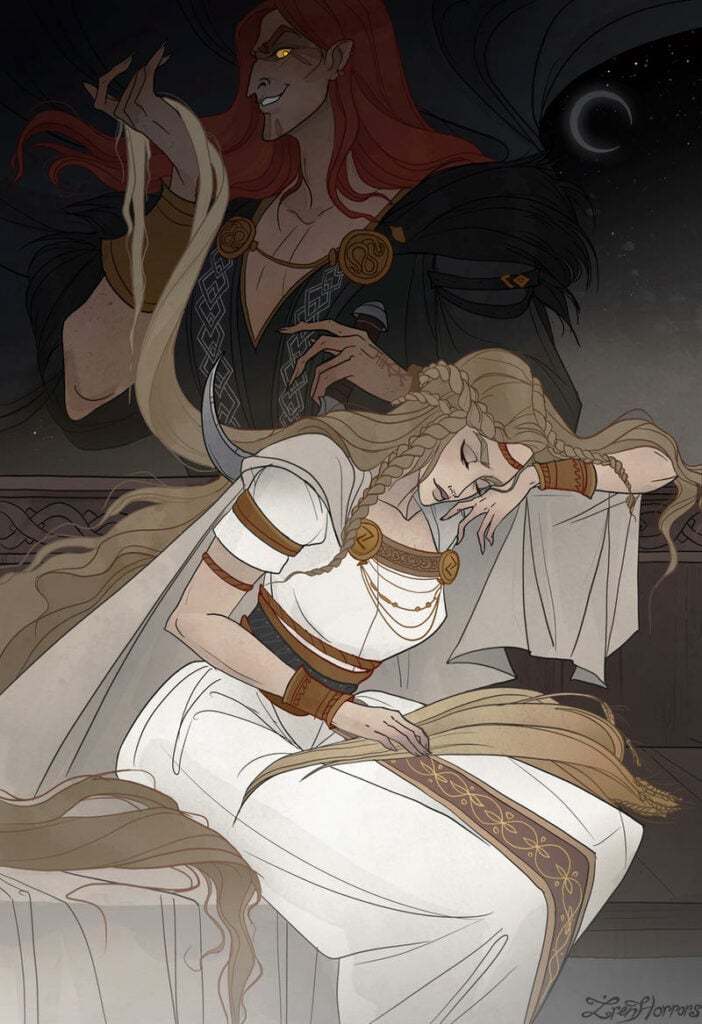
After that, Loki went to those dwarves who are called Ívaldi’s Sons; and they made the hair, and Skídbladnir also, and the spear which became Odin’s possession, and was called Gungnir.
— Snorri Sturluson, Skáldskaparmál, ch. 35
After they had made these three precious items and saved Loki from Thor’s wrath by giving Sif her new golden hair, Loki, as the trickster god he was, decided to wager his head that the black elves could not create three more things of equal virtue.
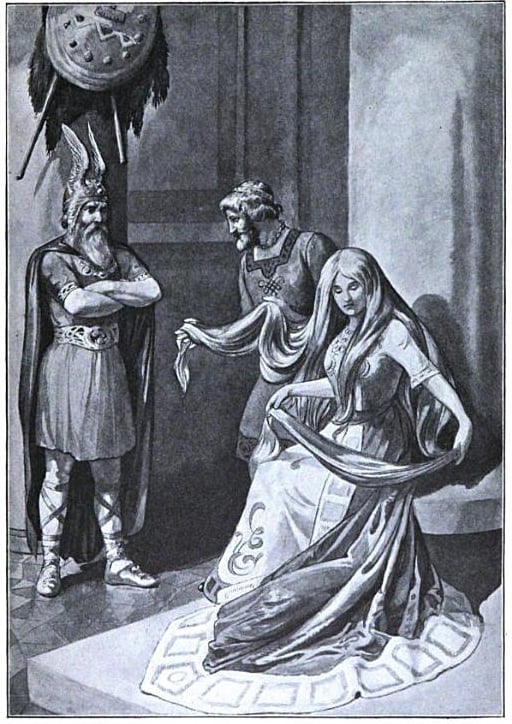
So they went to work to prove him wrong, and made three more items of equal worth, the third of which was a certain hammer:
Then he took from the forge a hammer, put all the precious works into the hands of Brokkr his brother, and bade him go with them to Asgård and claim the wager.
— Snorri Sturluson, Skáldskaparmál, ch. 35
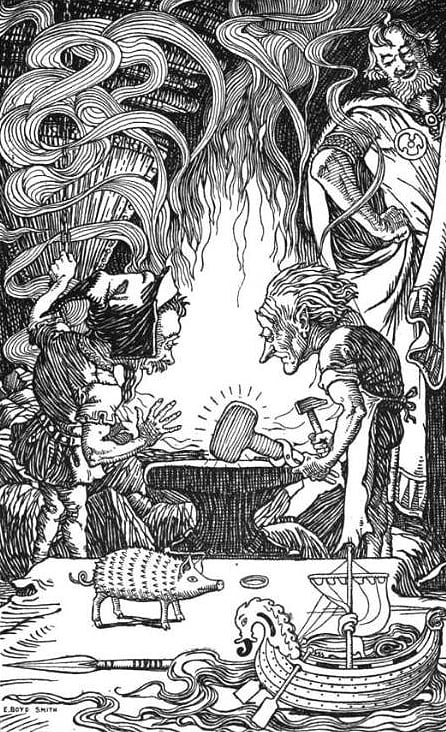
Arriving to Asgård, Brokkr and Sindri were eager to claim their prize from the wager with Loki, and presented the new items they’ve made.
As one could perhaps expect from Loki, he did not honor his wager in the end, and managed to get out of the situation with his head still on his shoulders, after much trickery and deception.
Loki’s Affair with Sif and General Instigations, Followed by the Wrath of Thor
Loki and Thor are often described as the fiercest of foes, not the least because Loki’s son Jörmungandr is destined to kill and be killed by Thor during Ragnarök.
Their animosity toward each other also stems from the time when Loki goes off on an epic rant against the other gods of Asgard, in which he claims all sorts of things to anger the other Æsir.
This includes a claim that he had an affair with Sif, the goddess of Earth and harvest and wife of Thor, which especially caused quite a stir in Asgard.
Here’s the situation as told in the Lokasenna (stanzas 53 and 54):
Then Sif went forward and poured out mead for Loki into a crystal cup and said: Welcome now, Loki, and take the crystal cup full of ancient mead, you should admit, that of the children of the Æsir, that I alone am blameless.
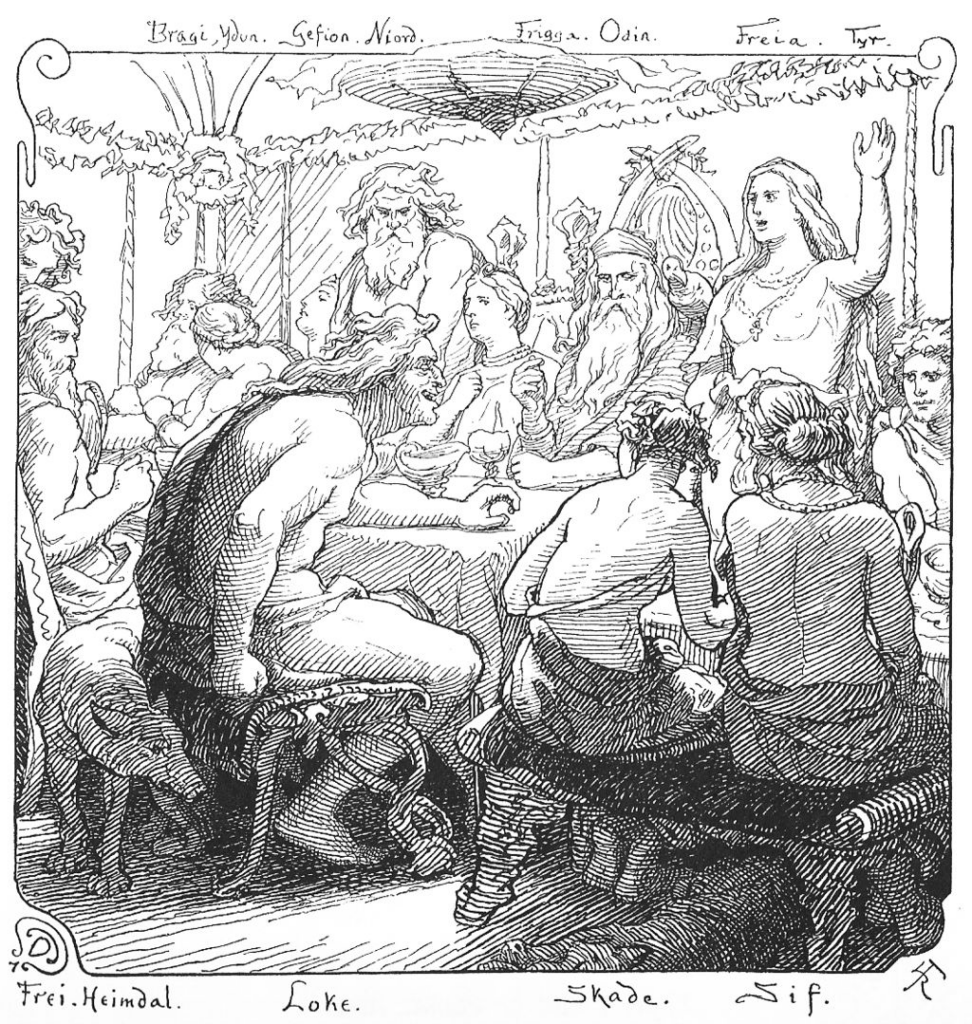
He took the horn and drank it down: That indeed you would be, if you were so, if you were shy and fierce towards men; I alone know, as I think I do now, your lover beside Thor, and that was the wicked Loki.
The ground shakes and Thor suddenly shows up, and when he finds out about the alleged affair he gets furious and cautions Loki to hold his tongue, which he of course does not.
Loki keeps going and starts insulting Thor in all kinds of manners, followed by Thor threatening to tear Loki apart and throw him into Hel, which ultimately deters Loki who finally backs down.
The Theft of Mjölnir and Thor’s & Loki’s Adventure with the Giants
You might not have guessed it, but Thor and Loki are not just epic foes, they also have a history of friendship and common quests! The most famous example is their adventure with the giants—a legendary tale of courage, friendship, trickery, and resilience.
It all begins when Thor discovers that his hammer, Mjölnir, has been stolen by the giant Thrym, which he tells his fellow Æsirs about, and a thing is called to solve the issue. Thor is desperate to get his hammer back, so the Æsir devise a plan to infiltrate Thrym’s domain and retrieve it.
To do so, Heimdallr suggests that Thor and Loki disguise themselves as Freyja and her bridesmaid, a plan that would satisfy Thrym’s desire for Freyja but which Thor is not a fan of at all. Loki manages to convince him though, as without Mjölnir Asgard is in danger of being conquered by the Jötnar.
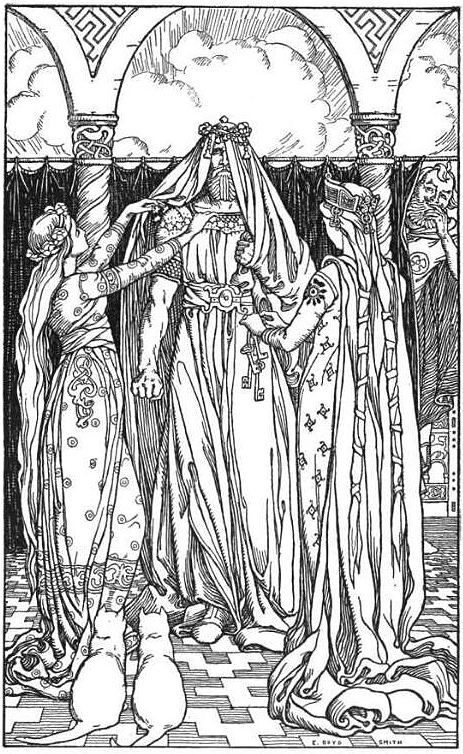
Thrym desires Freyja (the most beautiful goddess in Asgard) as the final proof of his immense wealth (which now includes Mjölnir), and he is willing to pay the hammer as a bride prize.
Along the way, Thor and Loki face many challenges – including outsmarting Utgard-Loki, the King of Giants – before they can ultimately succeed in reclaiming Mjölnir from Thrym.
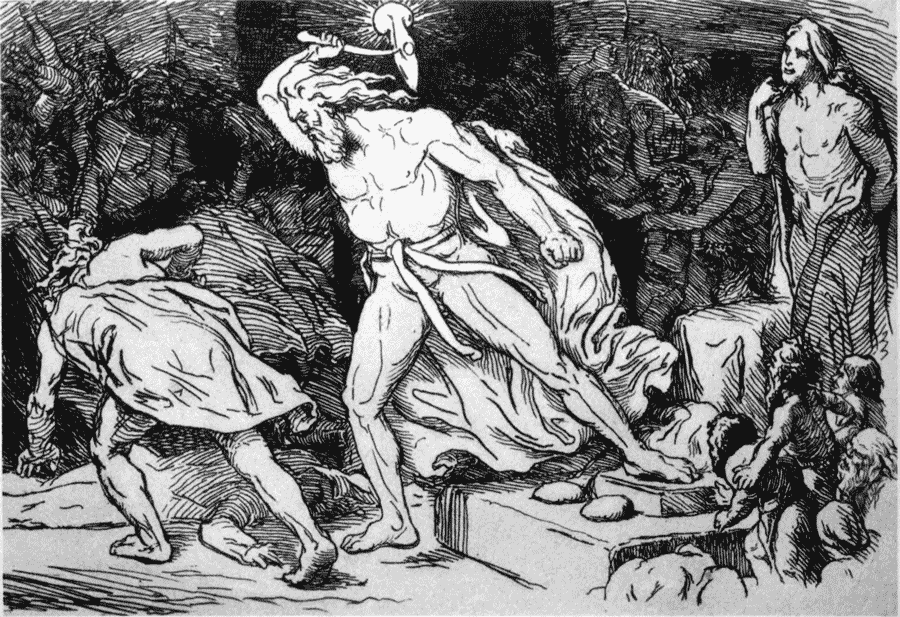
Thor’s and Hymer’s Fishing Trip & When They Managed to Hook the Midgård Serpent
In Hymiskviða we learn that the gods had been out hunting and wanted to throw a party to celebrate their successful hunt. It was decided that the sea god Aegir would host the feast, after which Thor told Aegir to make sure that there was plenty of mead, because without enough mead there can be no proper feast.
Aegir was not happy and tried to wriggle his way out of it by claiming that he did not have a large enough cauldron to brew mead for all the gods. However, if Thor could provide such a kettle he said he would host.
Tyr remembered that his father, the giant Hymer, had a cauldron a mile deep that just might be up to the task, so Thor and Tyr drove off in Thor’s chariot in search of the giant kettle.
Once they arrived at Hymer’s abode, it turned out that Hymer himself was not at home, and instead they were met by Tyr’s grandmother and mother. They offered drinks but adviced that Thor and Tyr should hide inside the big cauldron, because Hymer wasn’t always happy to see guests in his home.
When Hymer came home after a long day of hunting, exhausted, angry and with ice in his beard from the bitter cold, Tyr’s mother received him kindly and told him that he had reason to cheer up because his son had come to visit, and with a friend nonetheless!
Out came Thor and Tyr, and Hymer glared angrily at Thor, expecting no good from the visit. Still, he made sure that three bulls were slaughtered so that a meal could be prepared. Thor showed a voracious appetite, as he is prone to do, and astonished Hymer when he single-handedly ate the meat from two of the bulls.
The following day Hymer and Thor went out fishing to replenish the food supply after Thor’s epic chow-down, and when Thor asked for bait, Hymer angrily told him to fetch it himself. So Thor went to Hymer’s bull pasture, and twisted the head off the largest bull and took it with him into the boat.
Then he asked the giant to row far out to sea, for he intended to catch the Midgård Serpent himself.
It seems they had quite a good day out at sea, as Hymer apparently pulled up two whales before Thor had even thrown in his hook. When Thor had finally managed to bait his hook with the bull’s head, he also had good fortune when he—just as he set out to do—got the Midgård Serpent to bite.

Thor, in his struggle with the giant beast, took hold with such force that he trampled through the hull of the boat, whereupon Hymer, in sheer terror, cut off the line. There is also one version of the story where Thor managed to haul the Midgård Serpent into the boat and then proceeded top bash it on the head with his mighty hammer, causing the mountains to thunder and the earth to shake.
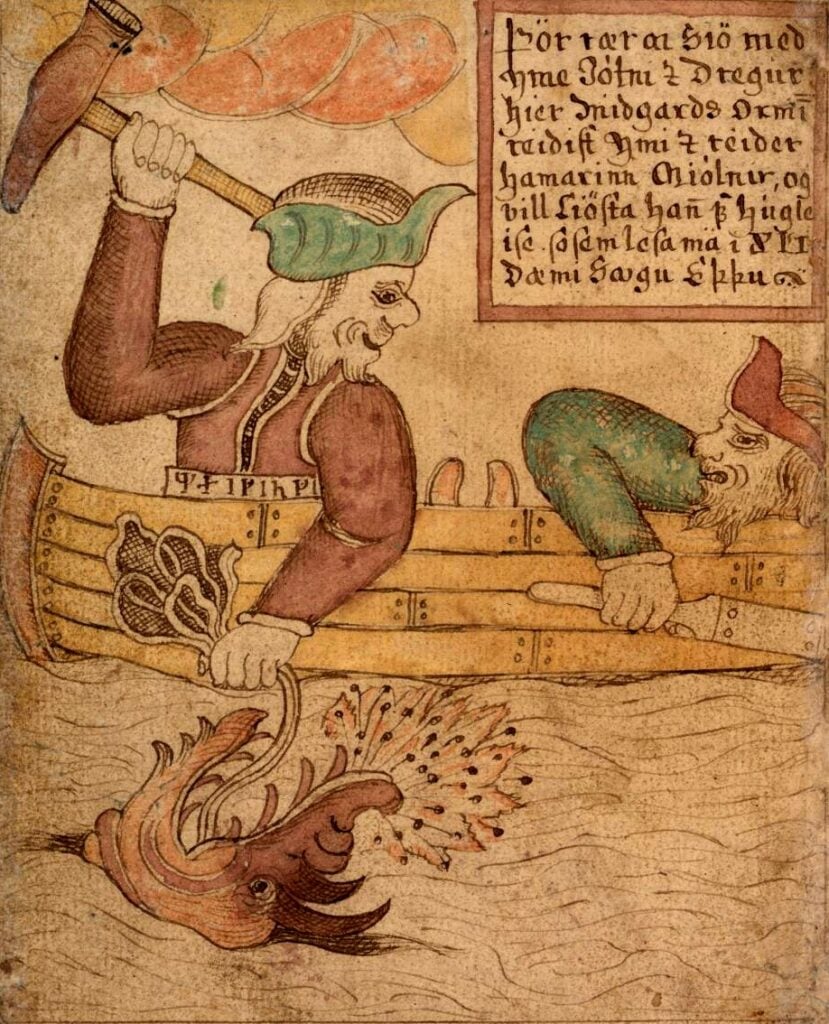
Either way, Tor’s display of extreme strength made Hymer wary, for he then rowed the boat back towards land without uttering a word. To bring the point home when they came back, Thor chose to grab the whole boat and its content and carry it up to the farm on his own.
Seeing this, Hymer pretended (pretty badly if you ask me) to be unconcerned and said that only someone who could to break his drinking horn could be called truly strong.
Of course, Thor could not resist this challenge. He grabbed the horn and hurled it against a stone pillar with all his might, breaking the pillar, but not the horn.
Tyre’s mother then hilariously advised Thor to smash the drinking horn into Hymer’s head instead, “for no one could have a thicker skull”. Said and done, Thor smashed the horn into Hymer’s head and shattered the horn.
Hymer was not too happy, despite being the one who suggested the whole thing, and bitterly told Thor and Tyre that they would have to carry out the mighty brewing cauldron they had come for themselves. Tyr tried twice, to no avail, after which Thor took a firm grip, lifted the cauldron on his head, and carried it away like nobodies business.
Hymer had of course hoped that they could not budge it, and his mood soured yet again upon seeing them walk away with the cauldron, which he himself thought was too heavy for anyone to carry.
In the end, Thor got his wish for a mead-filled feast at Aegir’s hall, with the giant brewing cauldron serving its purpose well.
Thor’s and Loki’s Journey to Utgård, and Their Humiliation
There is yet another tale of Thor and Loki out on an adventure together; the journey to Útgarða-Loki, which is told in a passage from Snorre’s Edda.
Their journey begins with Loki, Thor and his goats traveling across Jotunheim, along with two servants—Tjalve and Röskva. One night they find a colossal house to sleep in, which turns out to be the giant Skrymir’s mitten (which should give you a sense of how big the Jötnar were). Thor is disturbed by the giant’s snores and tries to kill him, but the giant barely notices the violent hammer blows.
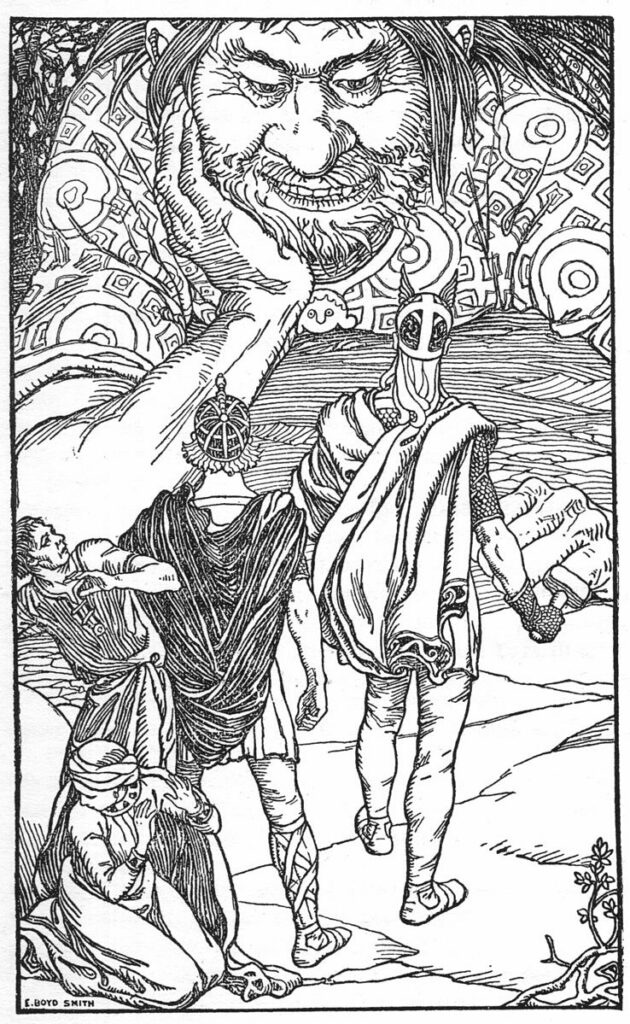
A little later they reach a castle (Utgård, or Útgarða) so high that they have to put their heads back to see over the crest. When they manage to get in, they meet King Útgarða-Loki in the high seat of a great hall, and when he sees Thor he smiles when he realizes how small he is.
He asks them what kind of sports they like, because all guests have to prove themselves better than others at some sport or art.
Loki then sets out on an eating contest with Loge, Tjalve gets into a running race with Huge, and Thor is tasked with to drinking up the horn that Utgard-Loki’s hirdmen (also giants) usually drink from and swallow in one or two gulps.
All three of them fail miserably, but Thor doesn’t want to give up so easily (he is after all famously stubborn). So, he instead convinces the King to try to lift the cat and wrestle with Útgarða-Loki’s old foster mother, Elle.
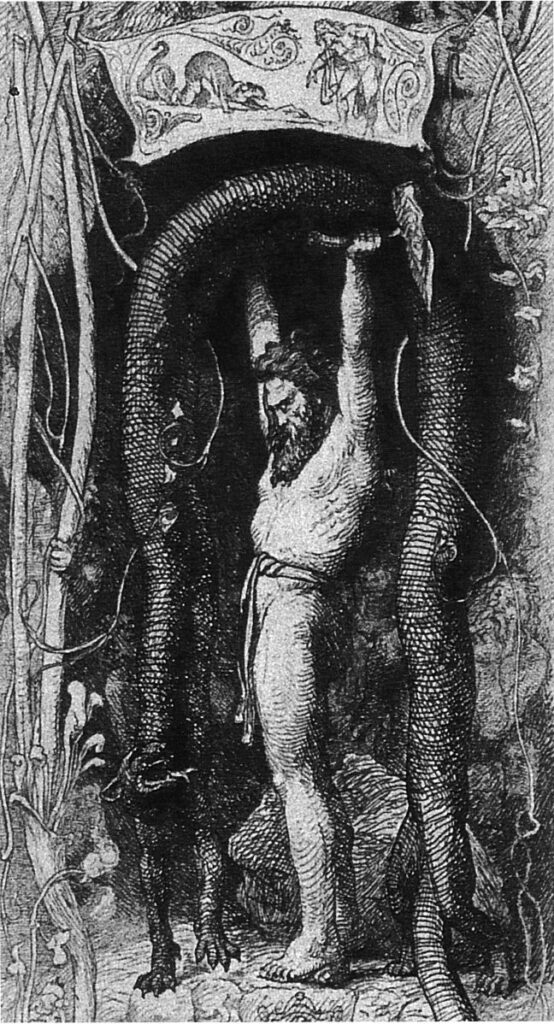
This doesn’t go well either, but the company is still treated with respect due to their honorable attempts to best the giants.
The next day, Útgarða-Loki takes his guests out, and he asks Thor what he thinks of his stay. Thor is not too happy at all, as he knows that the giants laugh at him due to his inability to best them at the challenges.
It is then revealed that Thor and his company had been tricked, as the giant Skrymir was actually Útgarða-Loki himself, Loki had to try to out-eat the fire (Loge is the same word as flame), and Tjalve had to race against Útgarða-Loki’s thought (his håg, also known as Huge).
Thor also found out that the horn from which he drank had its point in the world’s oceans, and there was a considerable ebb that had been brought about at the time. Finally, the one Thor had wrestled with was old age (Elle is also known as Age), which will sooner or later bring down even the strongest of men.
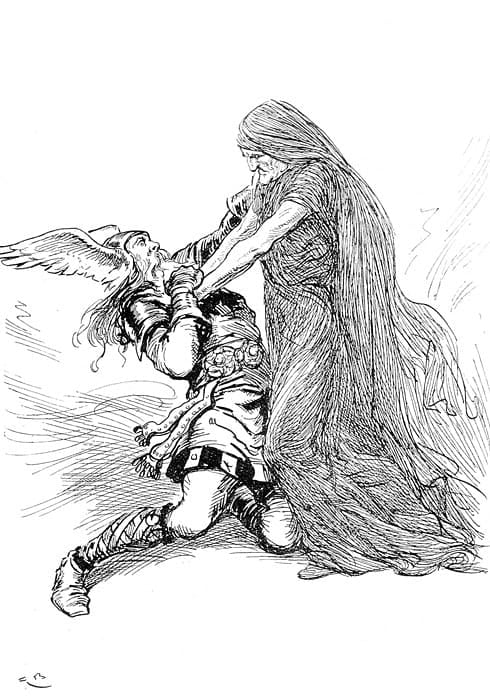
When Thor learns all of this, he wants to bring down both Útgarða-Loki and his castle with his hammer, but by then everything had already disappeared. They then begrudgingly return home.
Ragnarök, the Battle with Jörmungandr, and the Death of Thor
Ragnarök, the end of times, is foretold by the Völvas and will among other epic battles include the battle between Thor and Jörmungandr, known as the Midgård Serpent and an enormous snake that encircles the world.
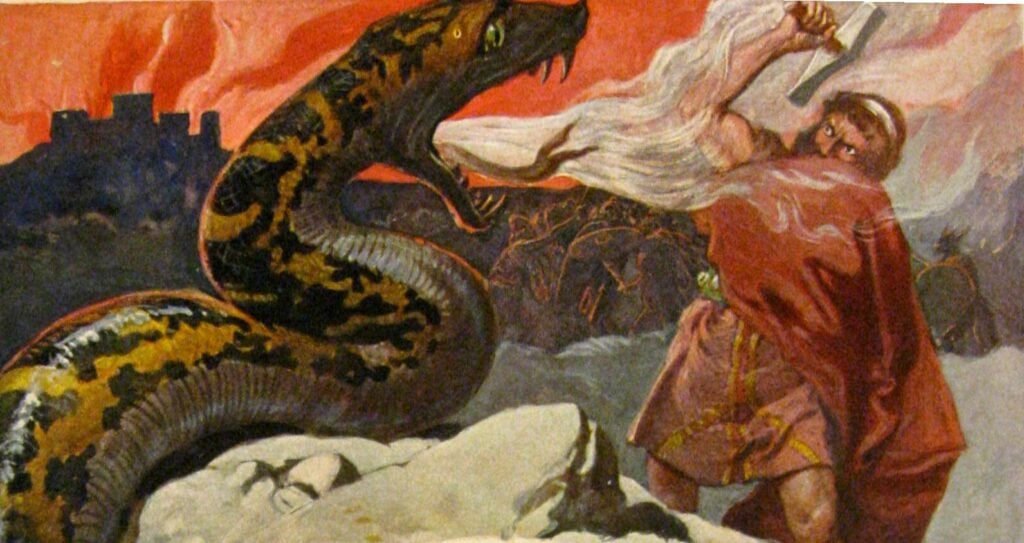
The two will fight to the death at Ragnarök and it is prophesied that Thor will slay Jörmungandr but succumb to its venomous poison after taking only nine steps away from its corpse. This battle marks the end of Ragnarök, with many of the gods falling in other simultaneous battles, including Odin himself.
The painting “Battle of the Doomed Gods” by Friedrich Wilhelm Heine perfectly captures this mythic moment as two great forces clash for eternity.
Archeological Records Associated with Thor
Thor is by far the most popular Norse god judging by the number of archeological records associated with him, with various artifacts, hammer pendants, and runestones found on sites from all over Europe; including modern-day Sweden, Norway, Denmark, Iceland, England, France, Germany, Russia, and Ukraine.
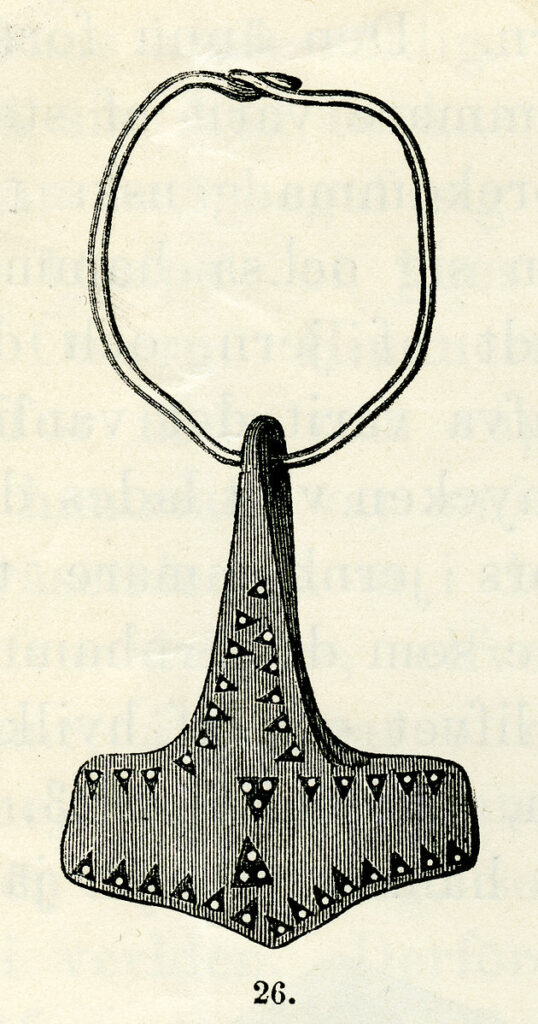
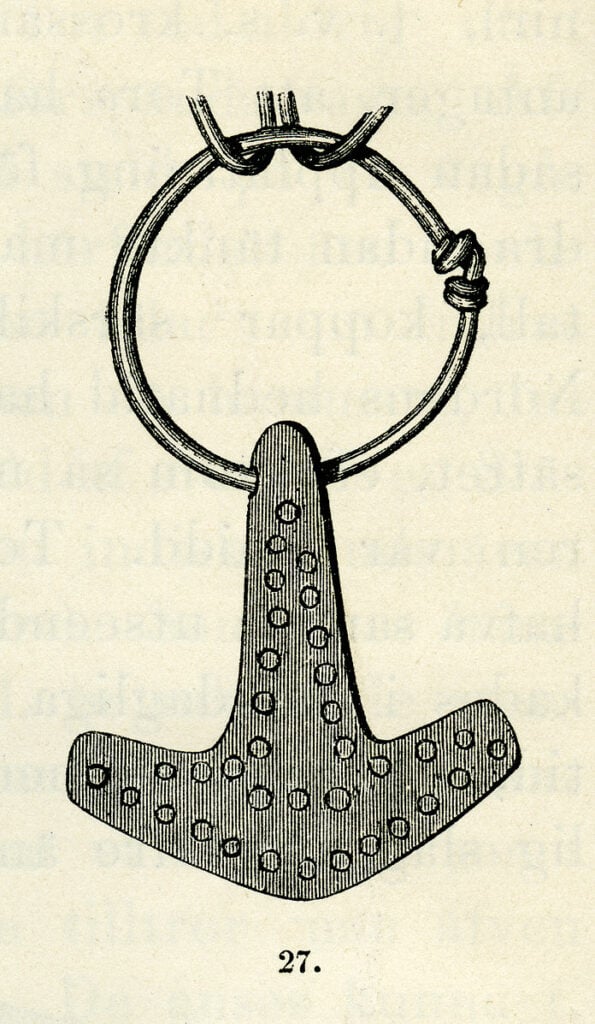
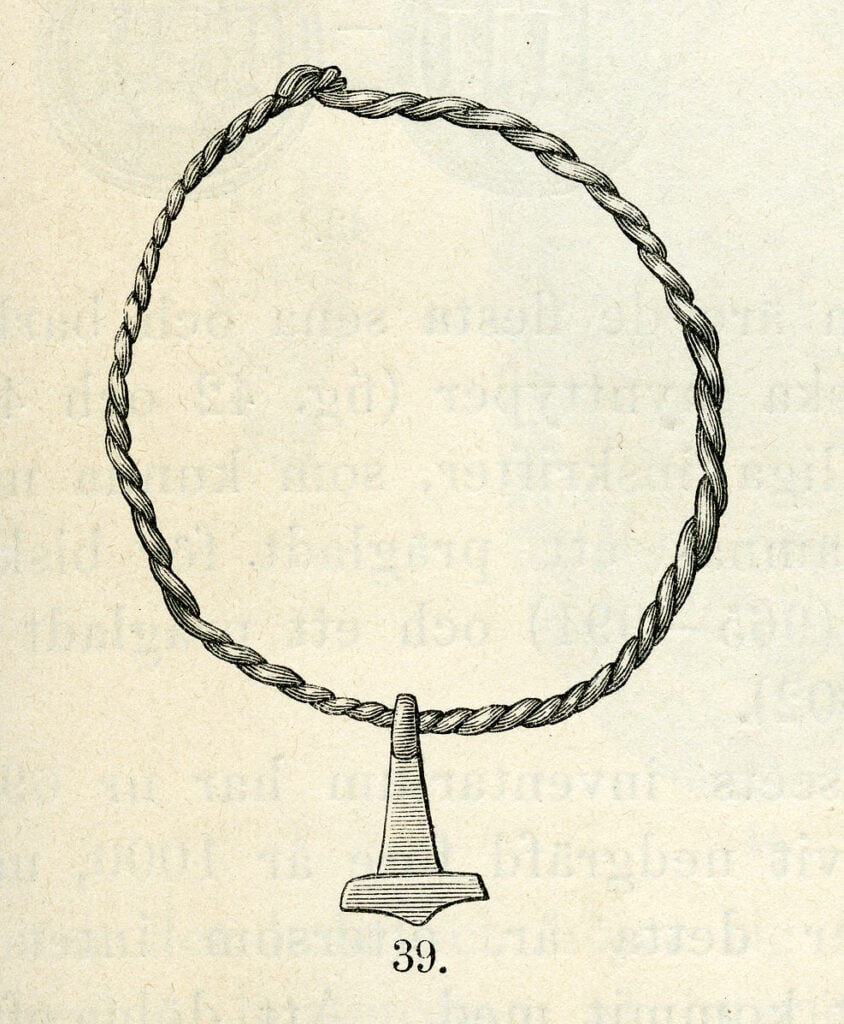
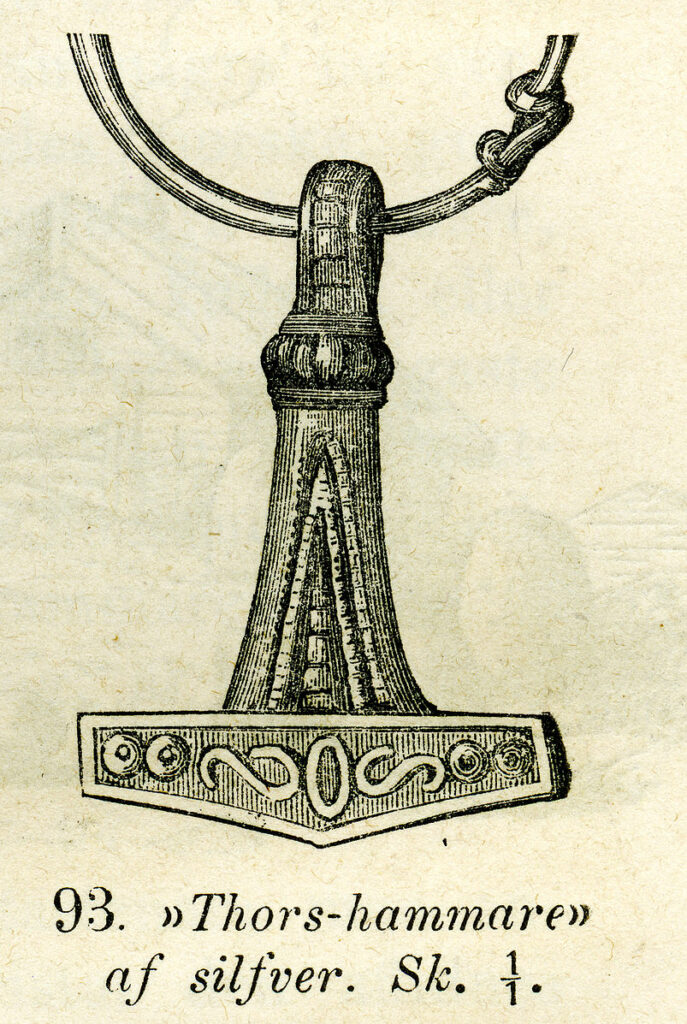
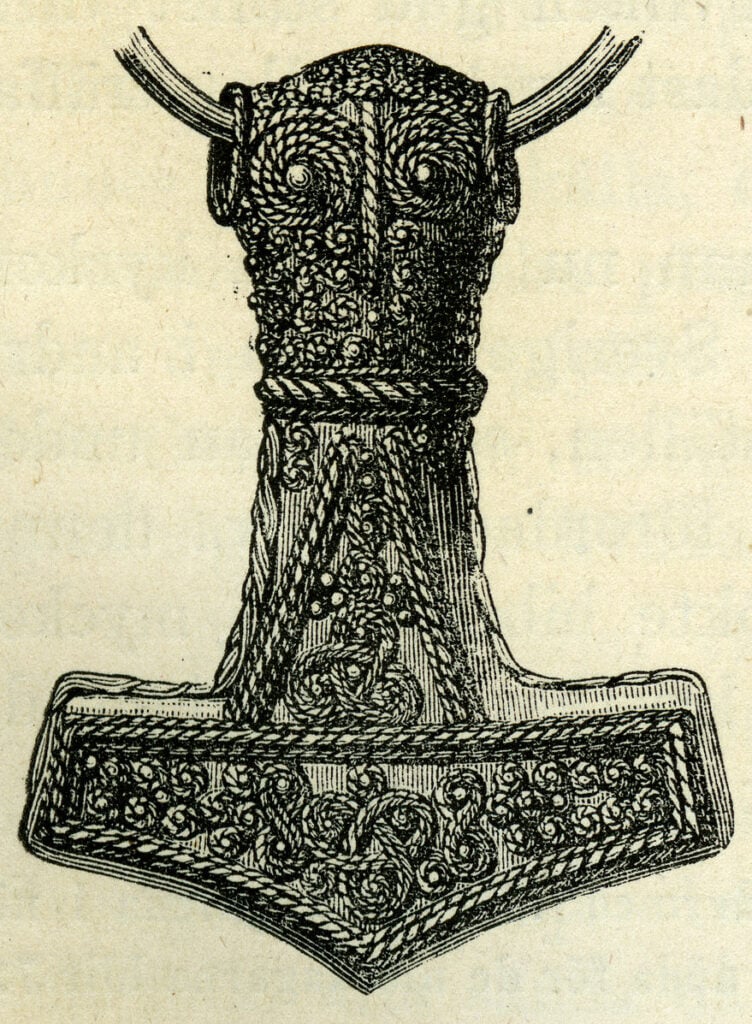

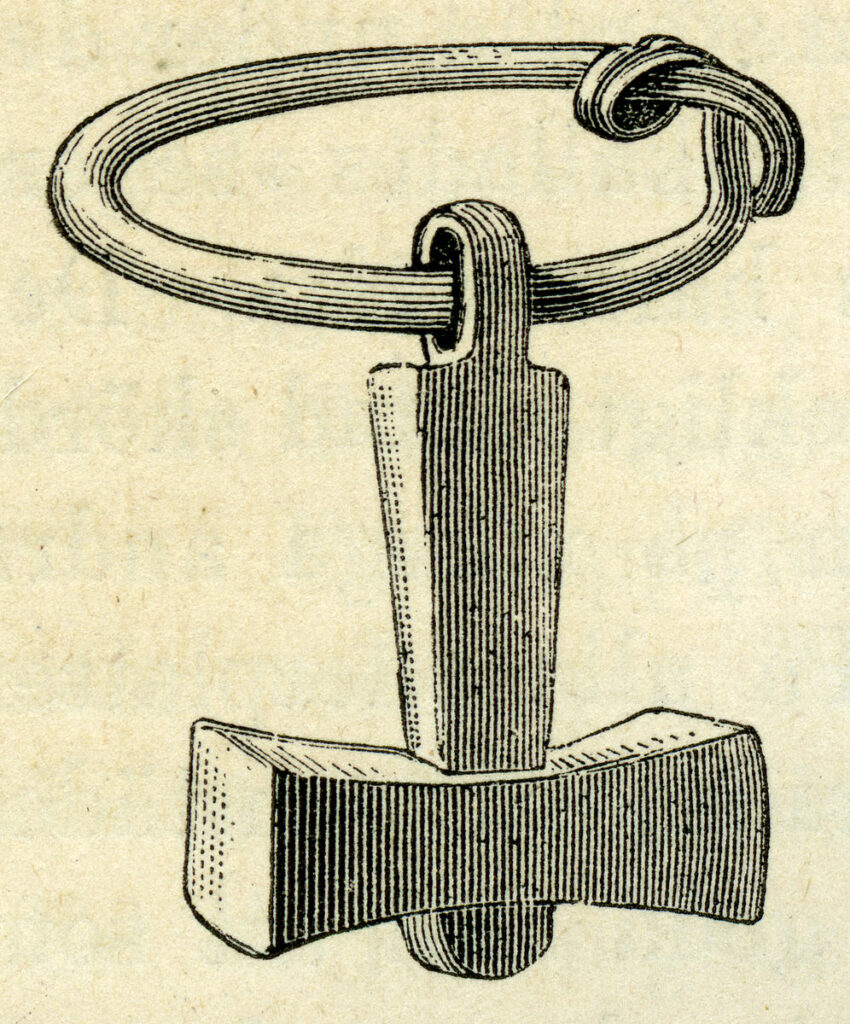
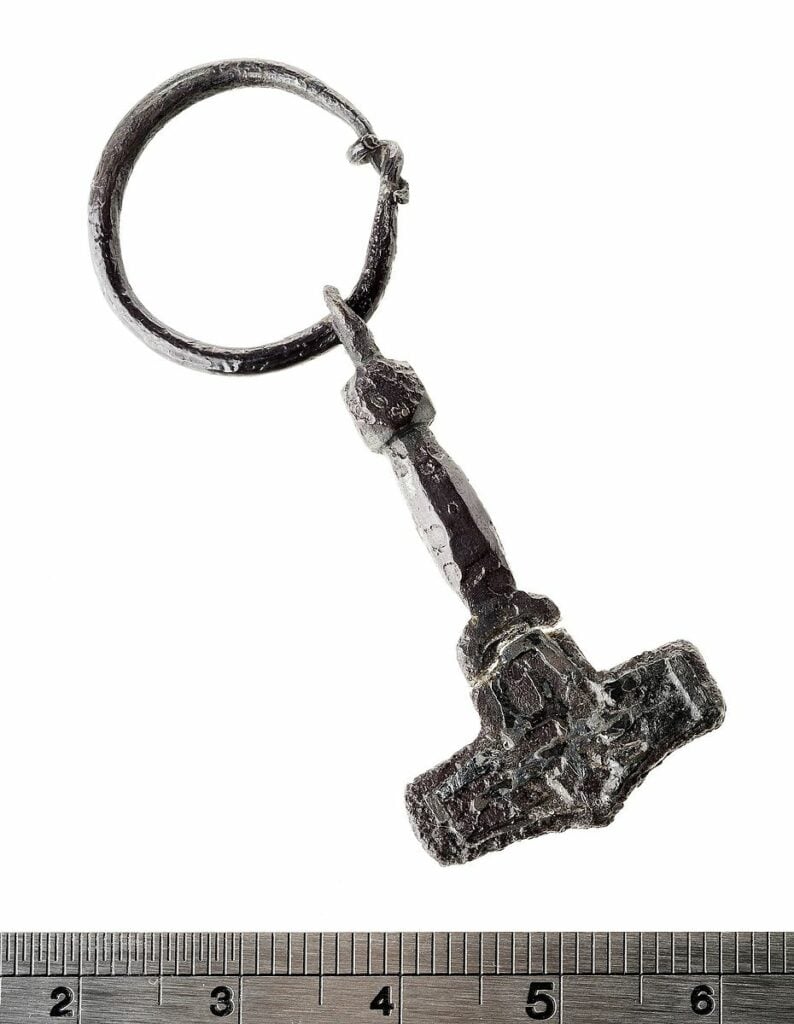
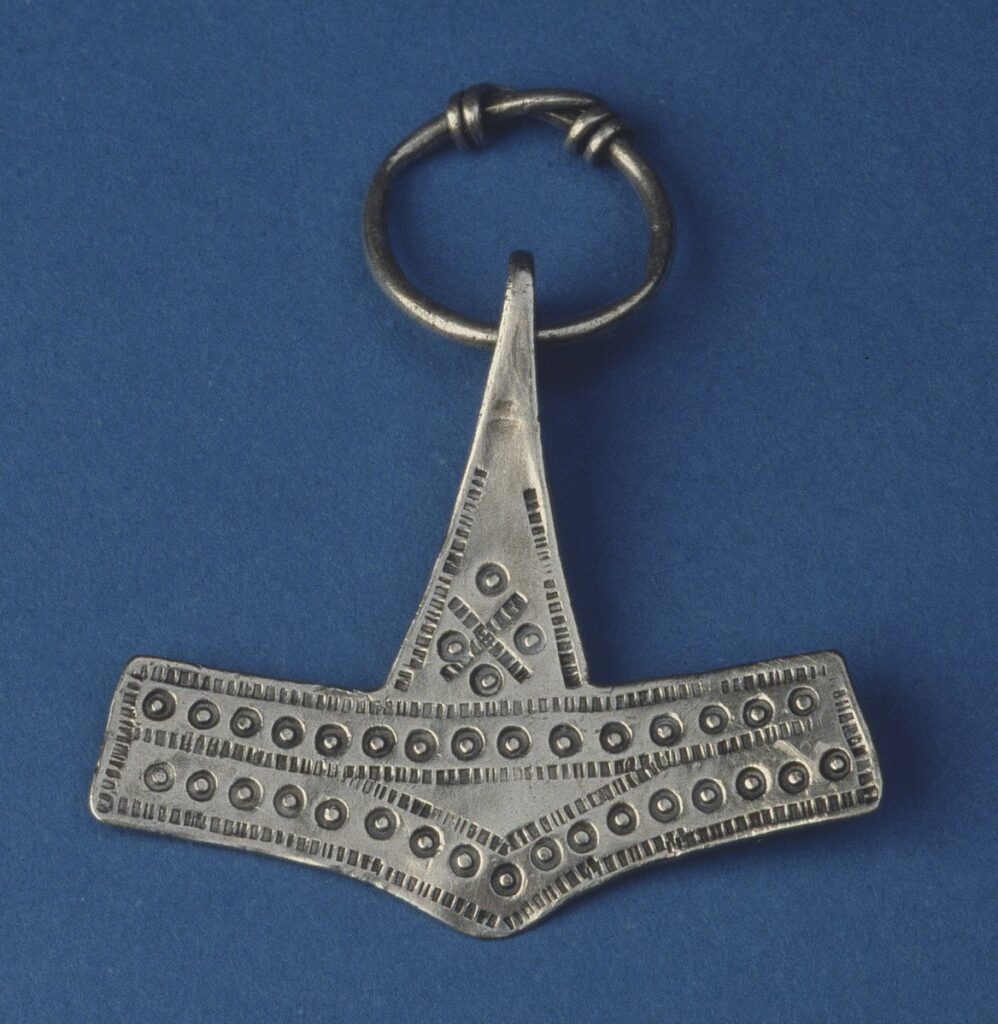
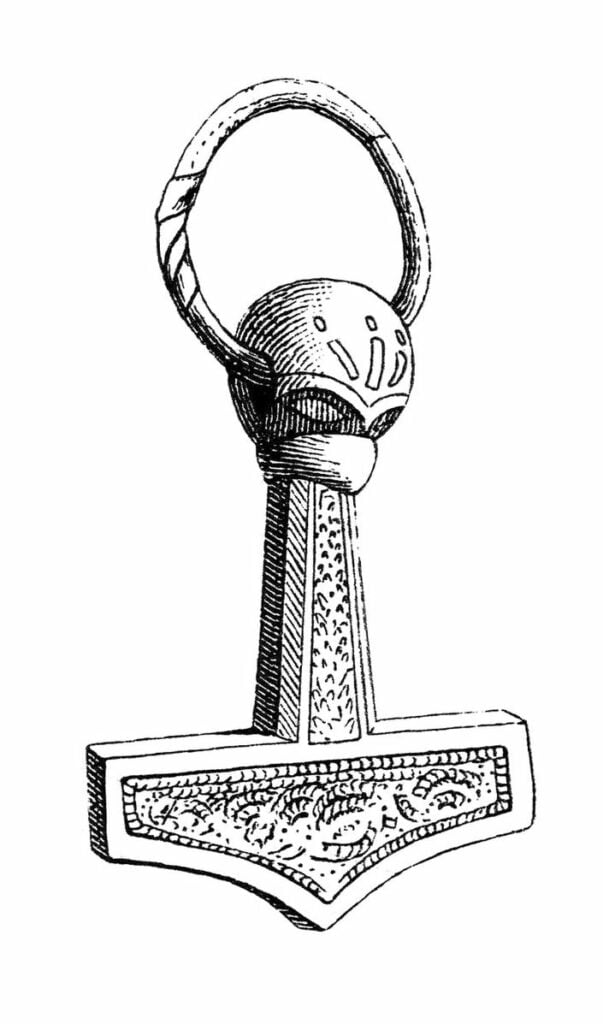
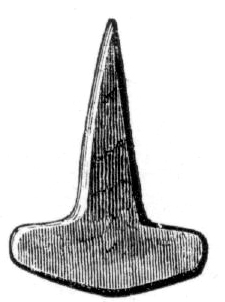
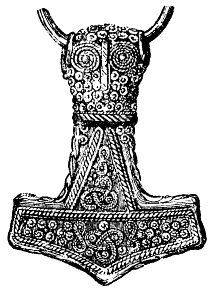
Most of these have been found in Scandinavia, where there are even rock carvings from 3000 years ago, during the Nordic Bronze Age, that are thought to be the earliest depictions of Thor wielding his lightning-making hammer.
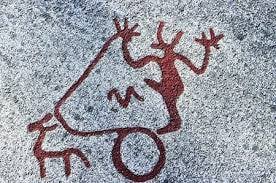
The carving includes a man driving a two-wheeled chariot drawn by a horse. The man holds the horse’s reins in one hand and a hammer in the other. Before him, a flash of lightning can be seen, so it’s hard not to assume that this is a bronze-age interpretation of Thor.
Some more recent Viking Age examples include the runestones in Stenkvista and Altuna in Sweden. Mjölnir is featured on the Stenkvista stone, and the Altuna stone depicts the story of when Thor goes out fishing with the giant Hymer, and accidentally hooks the Midgård Serpent.
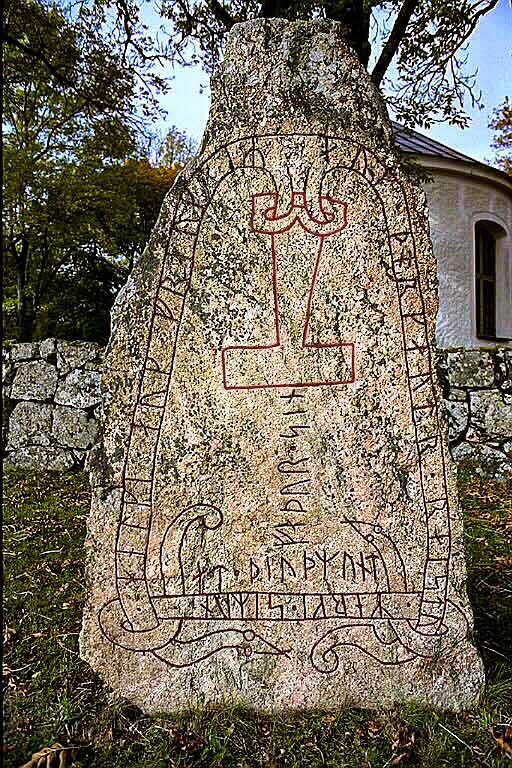
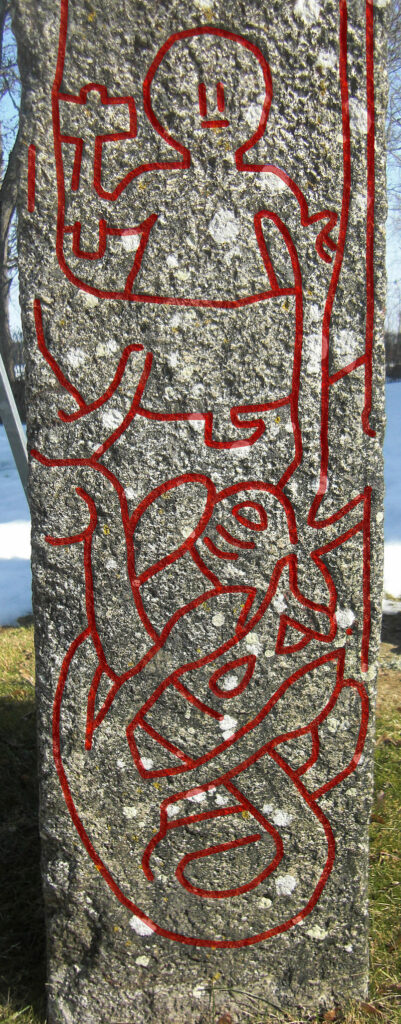
If you recall from a bit further up in the article, Thor baits his hook with an ox head to attract the Midgård serpent, and then uses such force to bring up Jörmundgandr that he tramples through the bottom of the boat with his feet, which is what we see on the stone.
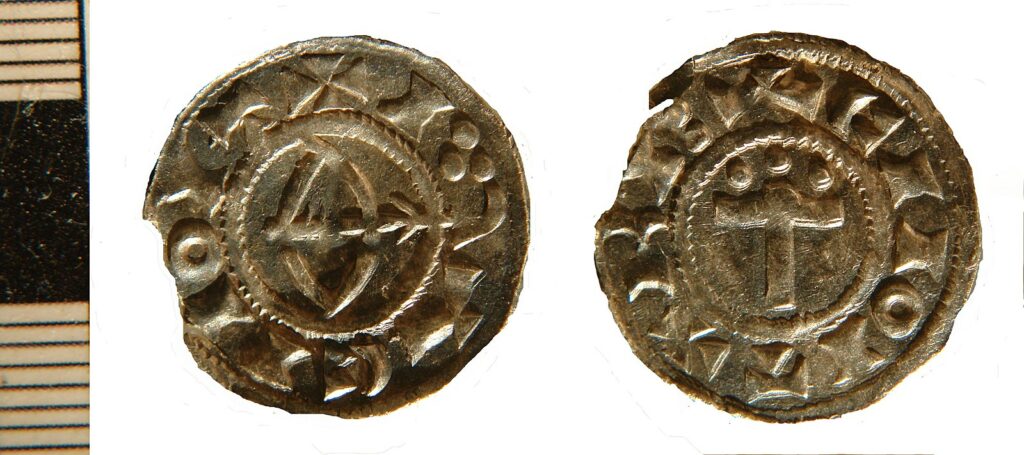
Modern Viking Art Depicting Thor
Due to his significance within Norse mythology numerous paintings and sculptures have been created over the years featuring Thor in various scenes – from battling with giants and serpents, to drinking mead and making thunder with his hammer.
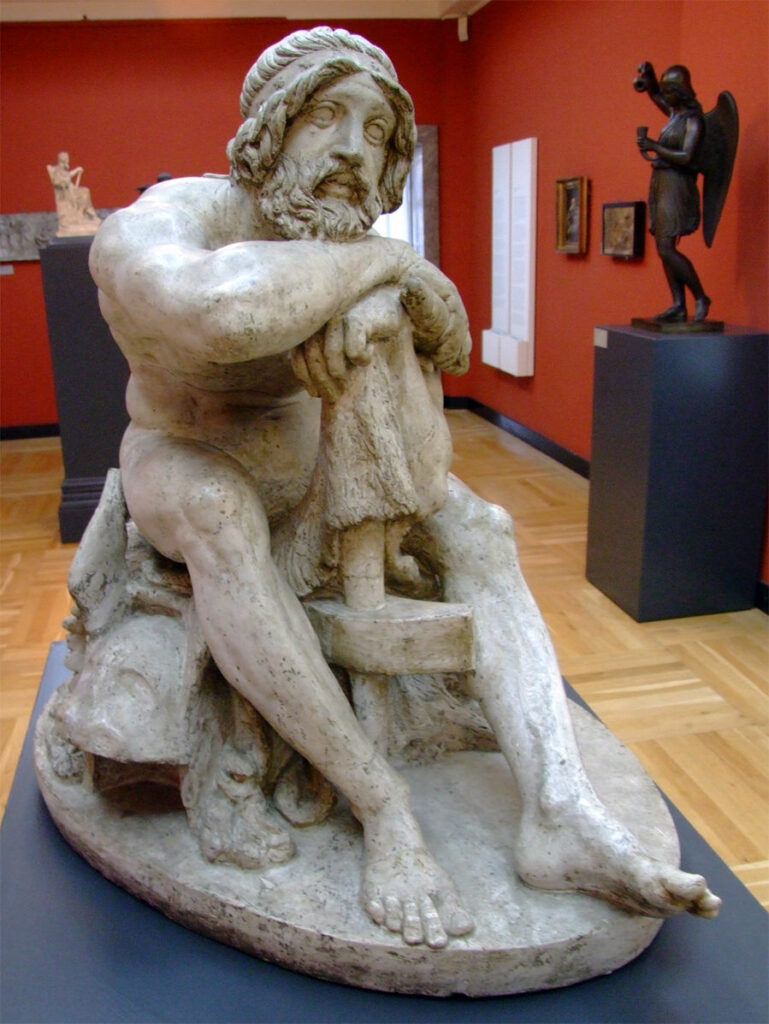
One such famous painting is Mårten Eskil Winge’s 1872 piece “Thor’s Battle With the Giants” which shows Thor wielding his mighty hammer Mjöllnir as he engages with Fenrir and a host of other creatures.
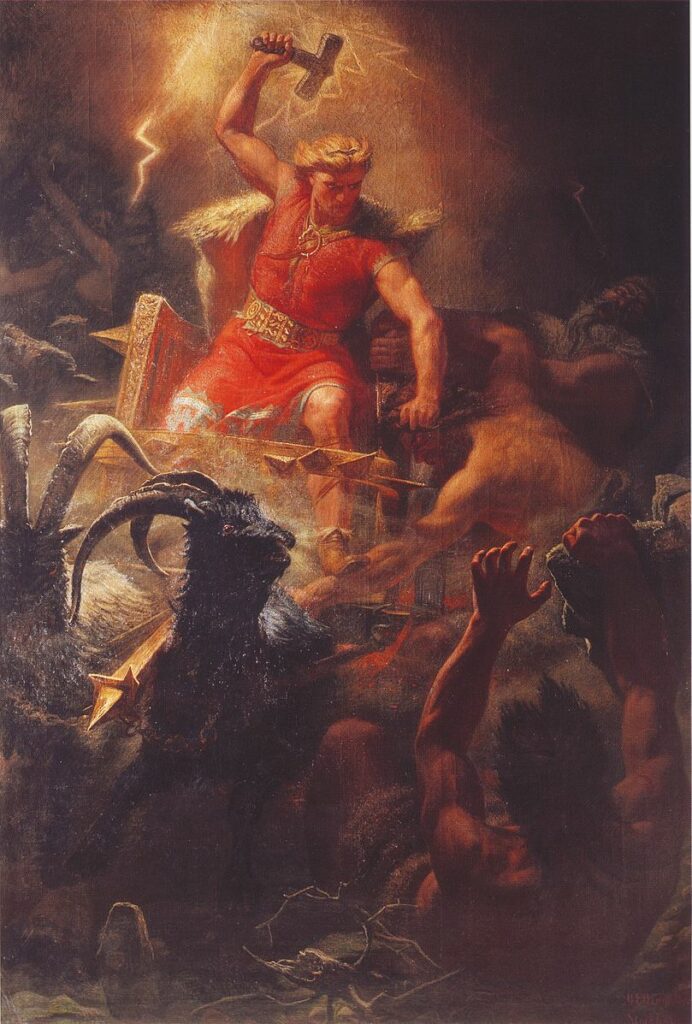
Other works of Viking art depicting Thor show him surrounded by allies such as Odin, Freya, Loki, Valkyries, Baldr, and other familiar figures from the Norse pantheon.
Thursday – Thor’s Day
Did you know that Thursday is literally Thor’s Day—named after the god of Thunder of both Norse and Germanic mythology?
In fact, four out of the seven days of the week are named after Norse gods—Tuesday (Tyr’s Day), Wednesday (Woden’s/Odin’s Day), Thursday (Thor’s Day), and Friday (Frigg’s Day).
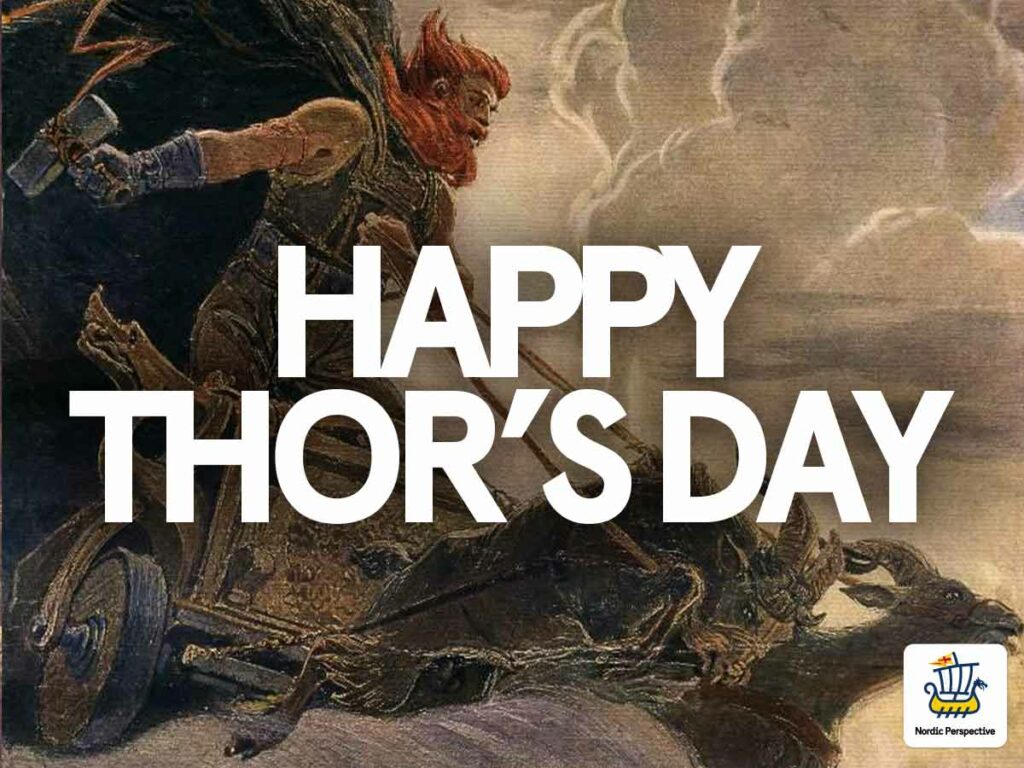
Thursday is more specifically derived from the Old English þunresdæg and Middle English Thuresday, and of course later influenced by the Old Norse Þórsdagr during the Viking Age.
Thor and Similar Gods from Around the World
There are numerous deities around the world who are associated with thunder, storms, and other attributes commonly linked with Thor.

These include Zeus from Greek Mythology; Jupiter from Roman Mythology; Ukko from Finnish Mythology; Perun from Slavic Mythology; Indra from Hindu Mythology; Taranis from Celtic Mythology; Shango or Xango from Yoruba/Santeria Mythology; Tlaloc from Aztec/Mayan/Inca Mythology; Raijin or Fujin from Japanese Shintoism and Marduk from Babylonian/Assyrian Mythology.
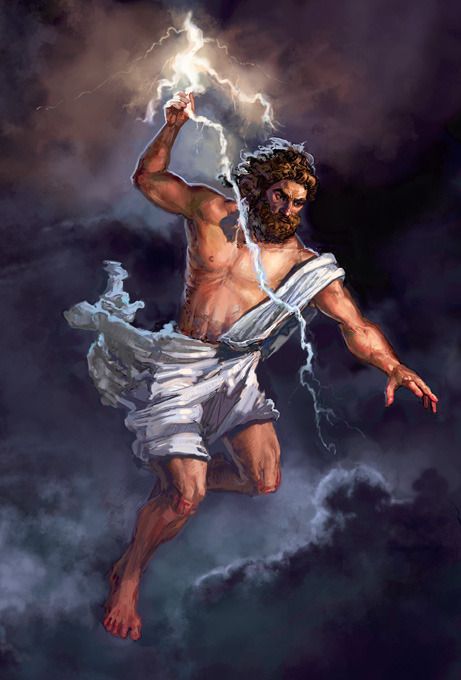
All these gods share similar traits to Thor, including being associated with thunderstorms, strength, and protection of mankind.
Modern Interpretations & Popularity
As you’ve probably discovered already, Thor has also become a very popular character in modern pop culture, having been featured heavily lately in Marvel comics and films, as well as various television shows.
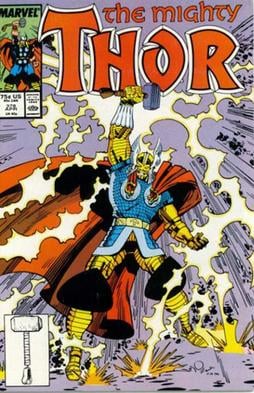
He was originally featured in a comic created by the legendary Stan Lee during the Silver Age of Marvel comics, and later we got to follow the MCU character Thor’s exploits through a multibillion-dollar movie and television franchise. The latest movie, Thor: Love and Thunder, recently passed $700 Million at the global box office, while the 2017 Thor: Ragnarök has generated $854 Million worldwide so far.
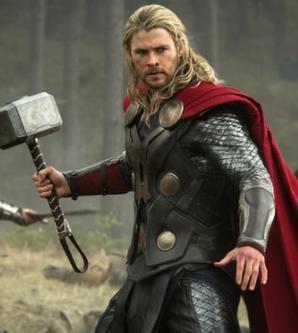
Copyright © 2010 Marvel Characters, Inc.
In addition to his appearance onscreen, Thor has also been featured in video games such as God of War (2018) and God of War Ragnarök (2022).
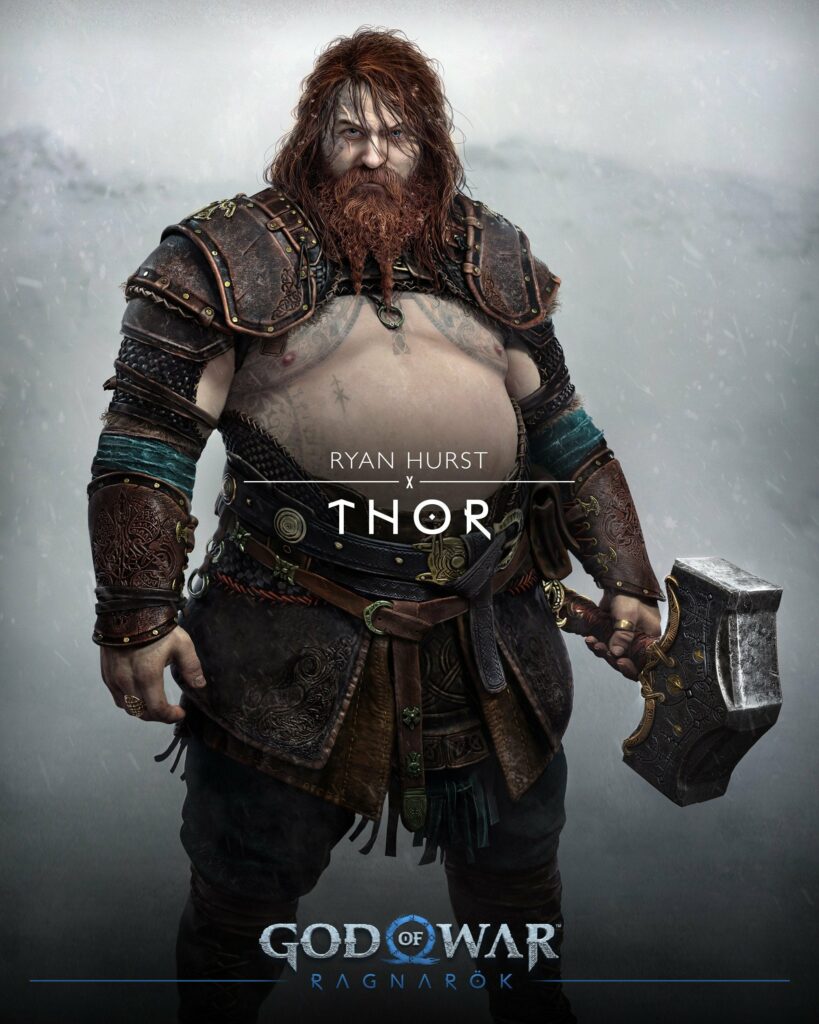
The portrayals of Thor onscreen and in video games have definitely helped to bring Norse mythology into the minds of many in recent years—and despite not always being true to the primary sources (such as the Eddas) or archeological records, I still think it’s great that so many people have been inspired to find out more about Thor and his Æsir buddies as a result.
Sources:
https://historiska.se/nordisk-mytologi/tor/
https://litteraturbanken.se/presentationer/specialomraden/RunornasLitteratur.html
https://sagadb.org/floamanna_saga.is
https://sagadb.org/eiriks_saga_rauda.en
https://books.google.com/books/about/Teutonic_Mythology.html?id=mDHXAAAAMAAJ
https://www.businessinsider.com/marvel-movies-ranked-how-much-money-at-global-box-office-2021-11
https://www.gutenberg.org/files/1150/1150-h/1150-h.htm
https://www.jstor.org/stable/27830385
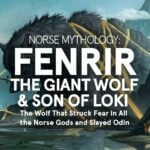 Fenrir: The Giant Wolf Who Slayed Odin in Norse Mythology
Fenrir: The Giant Wolf Who Slayed Odin in Norse Mythology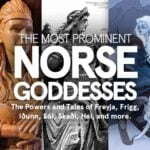 21 Norse Goddesses and Their Influence, Powers & Myths
21 Norse Goddesses and Their Influence, Powers & Myths Skaði: Norse Goddess of Winter, Mountains & Hunting
Skaði: Norse Goddess of Winter, Mountains & Hunting Viking Age Hairstyles & Beards: Historical & Modern Takes
Viking Age Hairstyles & Beards: Historical & Modern Takes

